It was a grey, cold, rainy day when I arrived in Grossenbrode, a small remote marina not far from the Island of Fehmarn, Germany´s “sunniest place”. The temperatures had just dropped to mere 10 degrees Celsius and except myself it seemed that nobody else wanted to set sails and go out this day, the marina was quiet. It didn´t bother me, on the contrary, I was delighted and motivated, standing in front of the Dufour Grandlarge 382, “my yacht”, a big smile covered my rainy face: This was going to be the first ever own command of a yacht. And hell, I was excited like a small kid on Christmas eve!
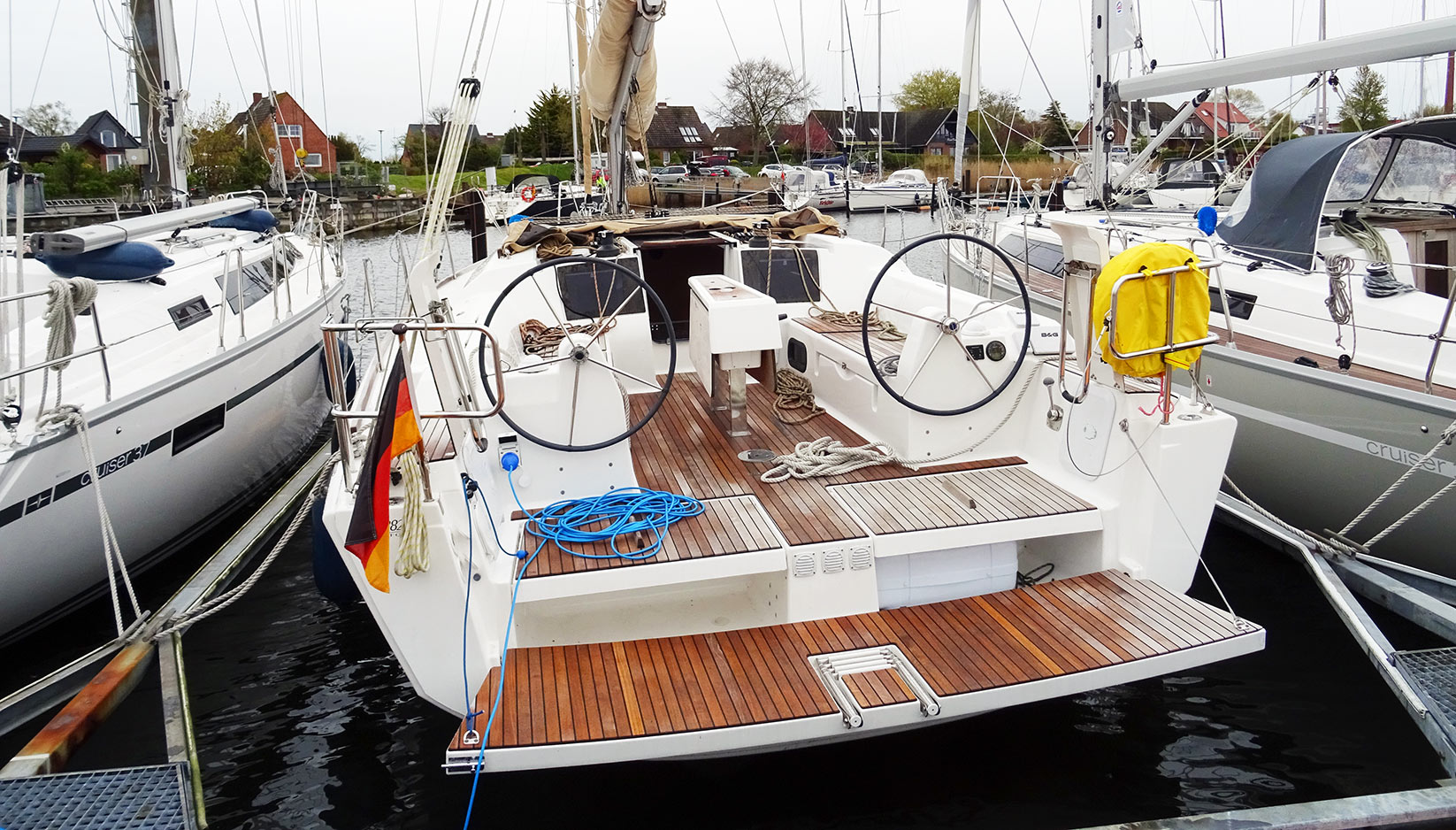
Since I started into sailing I was anticipating this day. Being the responsible person on board, the Captain, the Skipper. What a glorious moment. My heart was beating when I was signing the charter contract. I instantly liked her, “my boat”, the XENIA, which I was to be in charge of for the coming week. First time skipper: And I planned to be a good one. This article is about my first ever command, 300 nautical miles of being in charge of a sailing yacht and a crew. Here´s how I performed.
Role models: The Skipper I want to be
I took this very seriously from the beginning as sailing for me has more to do with respect and esteem than with having mere fun. This was always the case, even when I wasn´t educated and trained back in those days when I first sailed on a yacht when taking my own boat, OLIVIA, to the yard 2 years ago: Even then I tried to prepare myself as best as I could for the voyage (read it here). This time it´s not just the certifications I´ve acquired which enable me to prepare myself much better (read here and here and here about SKS/RYA Coastal Skipper exams) but also some 2.000 nautical miles of sailing experience under different skippers of whom I´ve found some quite capable role models.
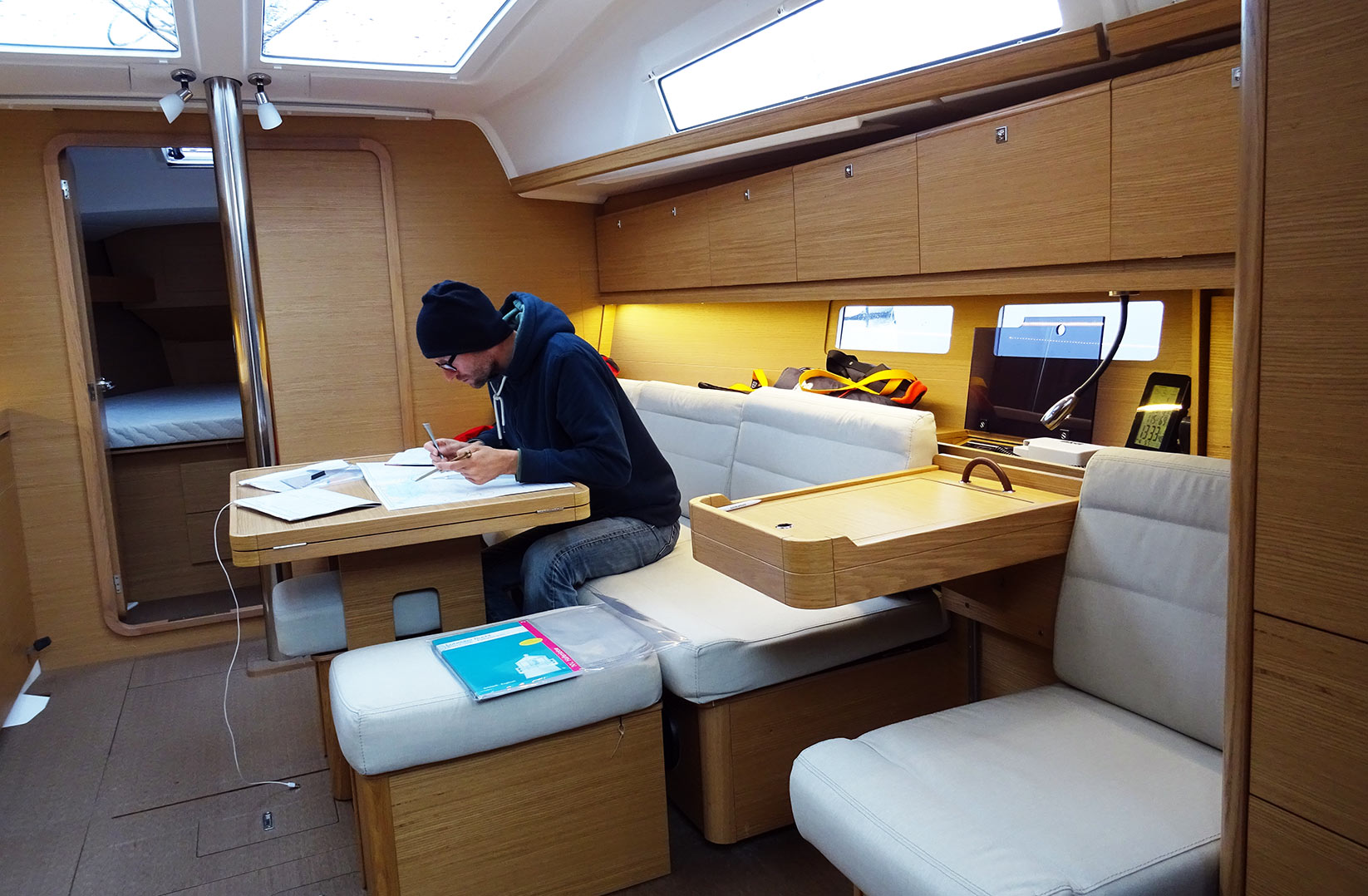
None of the skippers I had the pleasure to sail with had been hoisting sails flatfooted. They all knew what to do and when – they all had been prepared very elaborately. This is simply what I´ve emulated in the first place: I arrived some 2 hours earlier than my crew would. This gave me time to get to know the boat (Where is everything? Technical stuff, lines and roping, emergency equipment and so on). I was roaming every corner of the yacht, did the provisioning and after done so prepared the paperwork for the voyage. Upon arrival of the crew, I felt really in control of the boat already and I think I was emitting this confidence to the crew as well.
Knowing the boat
Let´s dive a bit deeper into this fact. After the approximately one hour lasting handover process with the charter company was completed, I did had my own schedule of getting to know the yacht. After loading the provisions into the stowage areas and making a provisioning list (ye, a bit oversized for a 7-day-cruise, but essential on long sailing trips for sure!) I went through the yacht to familiarize myself with the most important items: First of all, the navigational stuff. Sure, we´ve had a state-of-the-art chart plotter with touch screen capabilities on board, but nevertheless I sat down in the saloon to pre-plan the trip on a conventional nautical paper chart. I also made a schedule (waypoints, courses, traffic separation areas, beacons & lighthouses for example) for the first 12 hours of sailing because we were to leave at 6 p.m. and sail all through the night: I simply didn´t want to have to sit down and do this in the middle of the dark night.
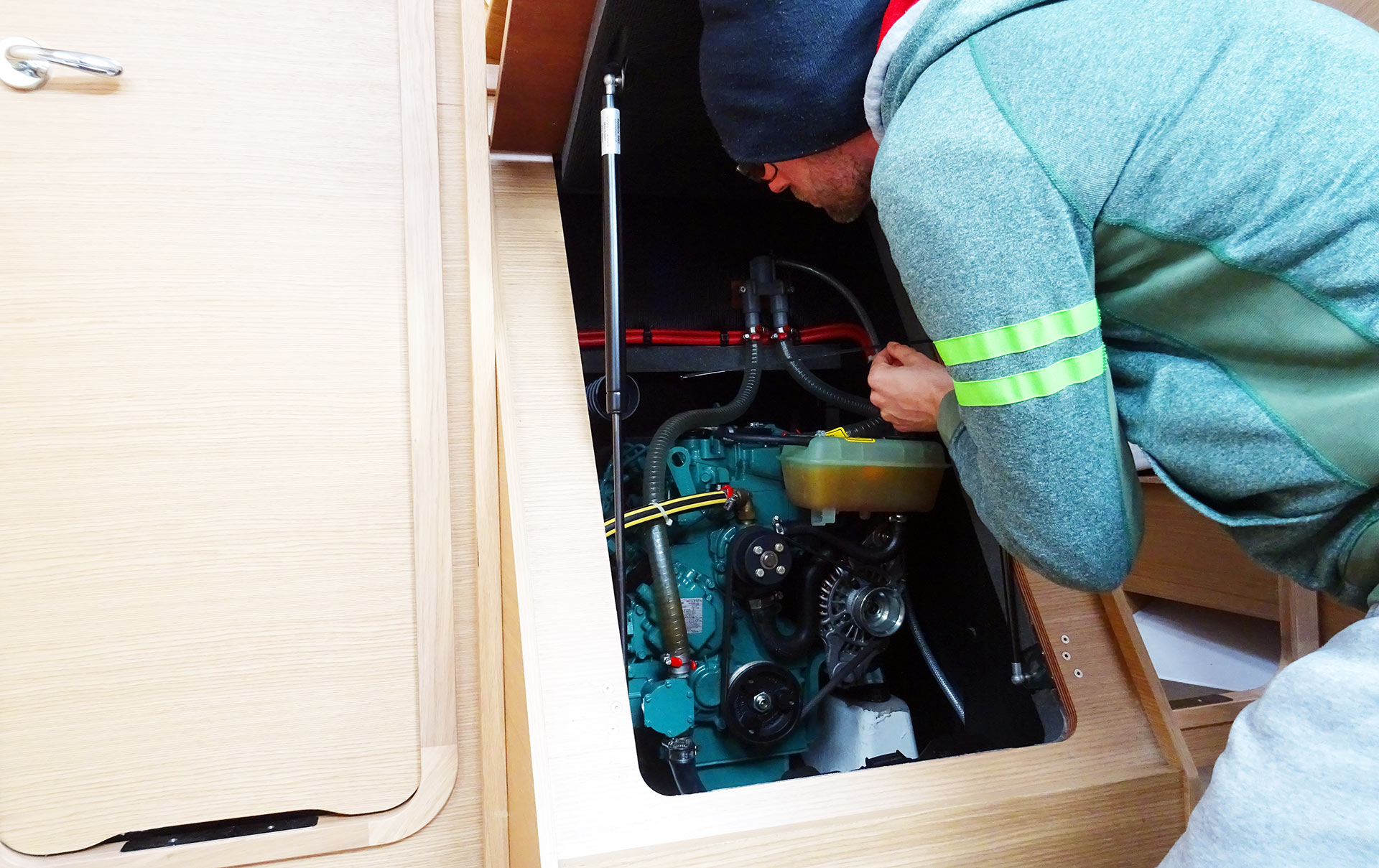
I also did a thorough technical check-up on the boat: Engine, coolant and oil, drive belt, engine bilge. All electric gadgets had been tested too, like all the position- and navigational lights, cabin lighting, autopilot (though I didn´t intend to use it and we indeed never did), steering & rudder, bilge, emergency stuff like life raft, signals, pumps, leakage tools et cetera. I also checked all ropes, clamps, winches and the proper function of the furling for the jib. When the crew arrived, I did truly know the boat inside out – at least, I knew where to go and look. Preparing a tea I could enjoy at least the last half of an hour prior arriving of my crew staring at the first – still empty – page of this trip´s logbook. Excitement was growing.
Starting with a new crew
A sailing yacht won´t sail without a crew (unless you do it single-handed, of course). I chose not to. Experiencing the burdens and joys of being a skipper also (and maybe foremost) means to be responsible for a crew. To guide them, to have them take over some of your responsibilities, to work hard and try to get the best out the yacht. “My” crew in this case was … just a single crew mate, Mathias. For him, it was the first ever “big” sailing trip after having completed the certification process as well. I chose to ask him not just because I like him as a pal, but also because of the fact that he is as (in-)experienced as I am. Doing this sailing trip with a more experienced sailor would have meant to naturally skip some of my duties to him. But I wanted the full program.

When Mathias arrived, after getting him a tea too, my first act as skipper was the thorough crew briefing. I´ve prepared a list of some 10 items in the logbook to run through with caution: Ship´s interior, ship´s exterior, safety instructions (of course!), fire and leaks, general rules on board, watch schedule, trip information & weather. It took me more than one hour to brief him on the boat and the trip. After the briefing I did make a note in the logbook: Crew was ready to cvast off.

I learned more about being in charge of a crew later, when we were underway. We had been lucky to set full canvas to sail into the night as our boat was joyfully jumping up and down the waves as we were heading East in upwind conditions with an average of 7 to 7.5 knots over ground. It was a sailing no-brainer for Mathias when he was alone up there in the dark standing his watch, nevertheless, as skipper I could never find real rest down below off-watch being responsible for the boat even then. I found it demanding to simply let go and lay down. A new experience for sure.

When we arrived in Stralsund, a very beautiful town in Eastern Germany, our yacht was used by TV-actors for sailing practice. As there was a shortage of skippers, I got my own training crew aboard and partially trained the celebs in gybing, tacking and MOB code of practice as well. Which was a bit more demanding as there is a difference for sure between having one crew mate on the one hand and having a crew of five people on the other. I performed well, I would say, by running a mix of being kind of a mate and keeping my distance on the contrary, preserving kind of an aura of the skipper to which even the stars used to look up (at least when we had been underway). It really worked out. In the end, I found it demanding but not so difficult of commandeering a crew.
Being underway
Weather improved after we set sails and on the second day it was warm and bright. Sadly, wind had ceased to blow so we had to use the engine, but that didn´t keep us from standing attentive watches as we have been cruising around in quite crowded areas of commercial traffic. Swell was going high and the motion of the yacht was quite hard as we were going upwind and running against the waves. I was used to it, still living on the experiences I´ve got on the Atlantic ocean some weeks ago but for Mathias it seemed kind of a new record.
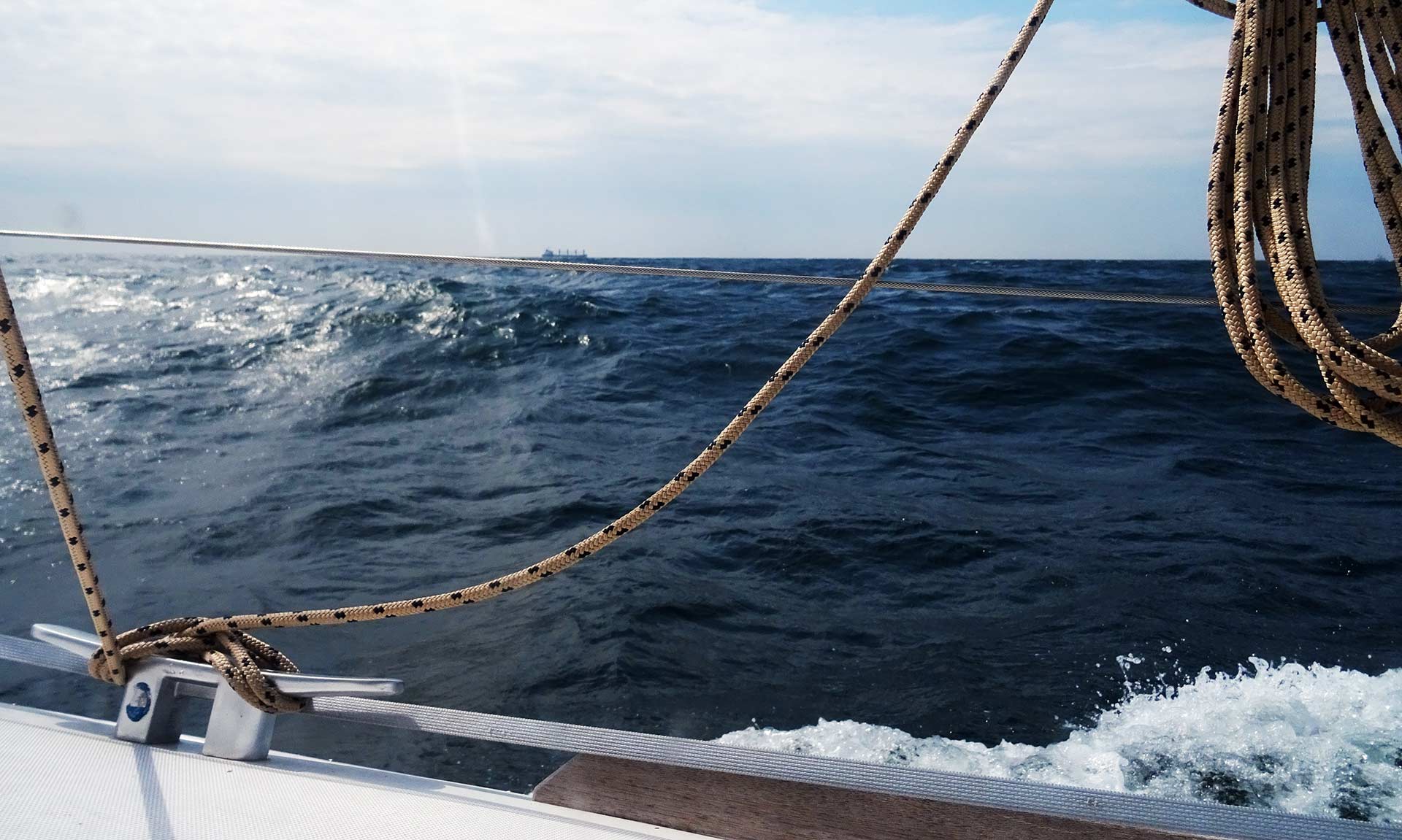
We did not use the autopilot, even under engine. Holding course by hand trains both the ability to control a boat, to anticipate the motion of the seas and react before the yacht is set off course by rolling – it also trains in a broader sense what drift and leeway do to a ship´s position in the long term process. Best thing, of course, was when we were able to hoist all sails, the boat heeled over and we were running fast driven by the mere power of the wind. I simply enjoyed my watches, especially at night with all the lights.
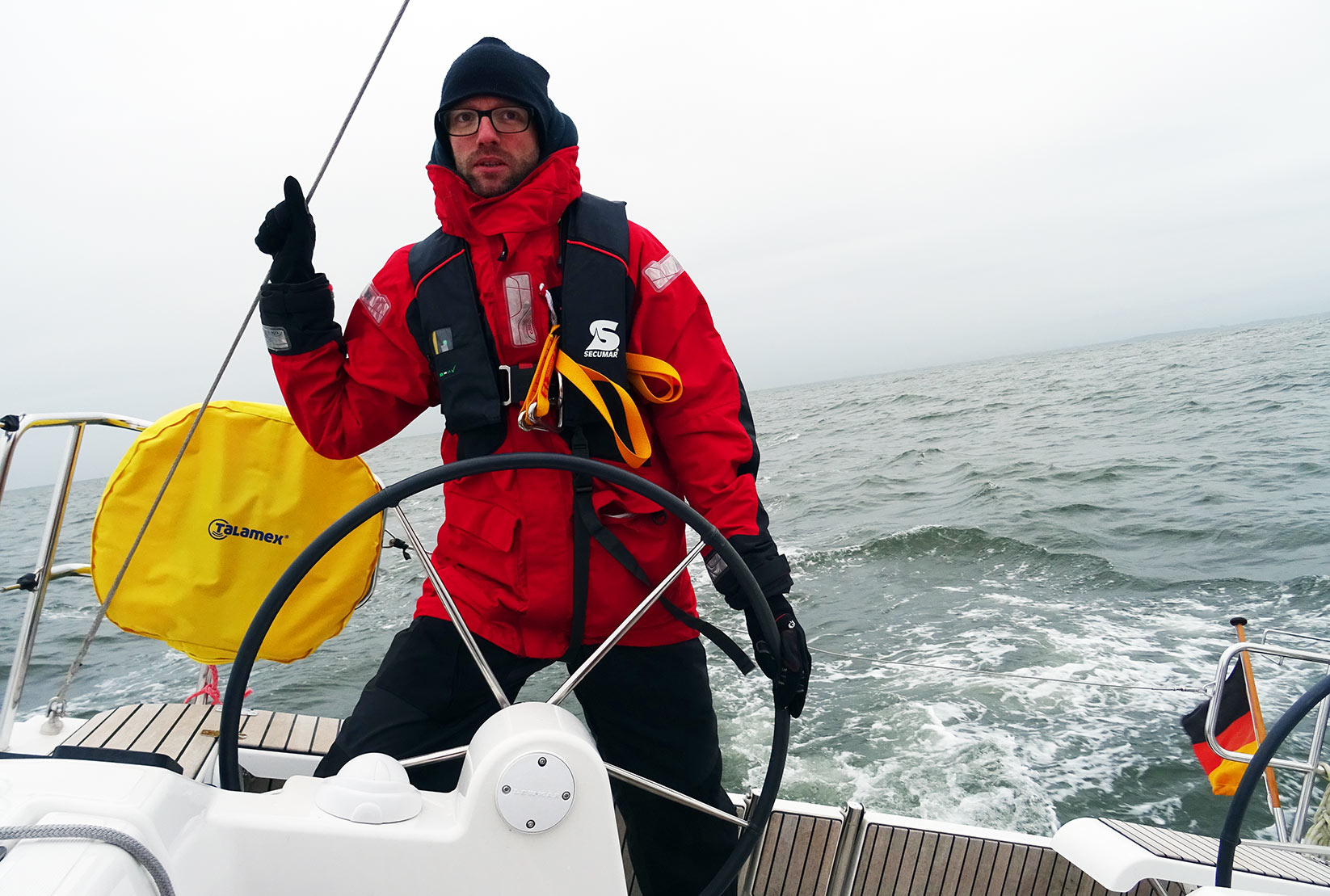
Which brings me to the navigational aspects of this trip. As I mentioned, our yacht has been equipped with latest gadgetry of high tech plotters. Which I tended to ignore when sailing on the open seas, it was just the compass with COG-heading that was of real interest here. The rest was done down below deck on nautical paper charts: Every second hour, during the night time every single hour, I transferred our GPS-accurate position onto the paper chart and hand-plotted a (new) heading to our next waypoint, announcing the changes to the helmsman. I identified buoys, light houses and other lights of interest, got on deck and talked them through with Mathias. I found it not only demanding and great fun to work this way (without digital plotting), but also very easy to do and in the end a very accurate style of navigating the boat.
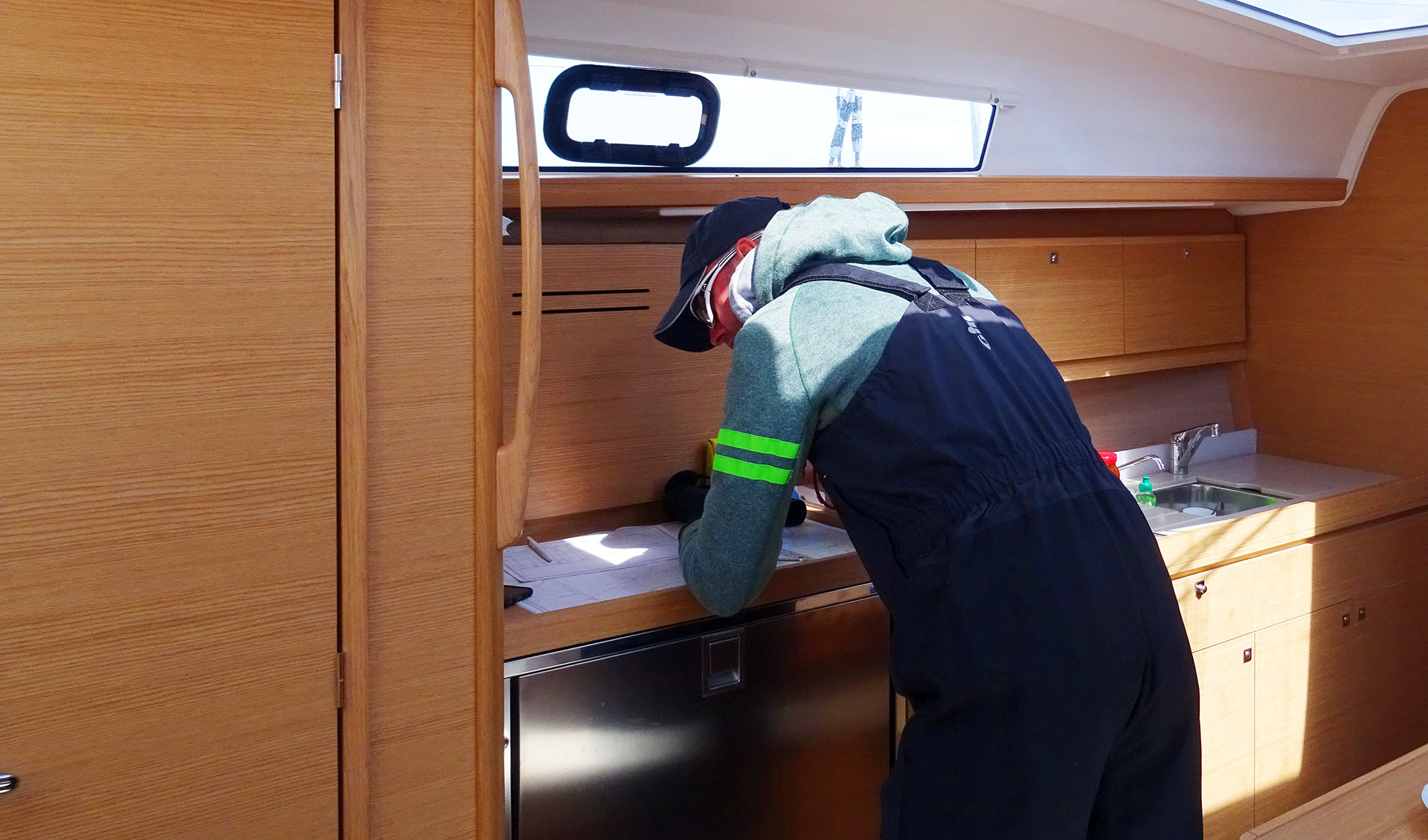
Solely relying on digital navigational aides such as the plotter maybe very comfortable, but I find the lack of the greater context dangerous. By working with paper charts you naturally have to have the broader image, the context in which you are moving, you simply get to know the area you are sailing in. When looking onto the chart, finding your position and plotting the course for the next one or two hours you automatically get familiar with all the surrounding landmarks, offshore wind parks, traffic lanes, islands, lighthouses and much more. This is a thing of safety as well: You know where you are and knowing is always better than not knowing.
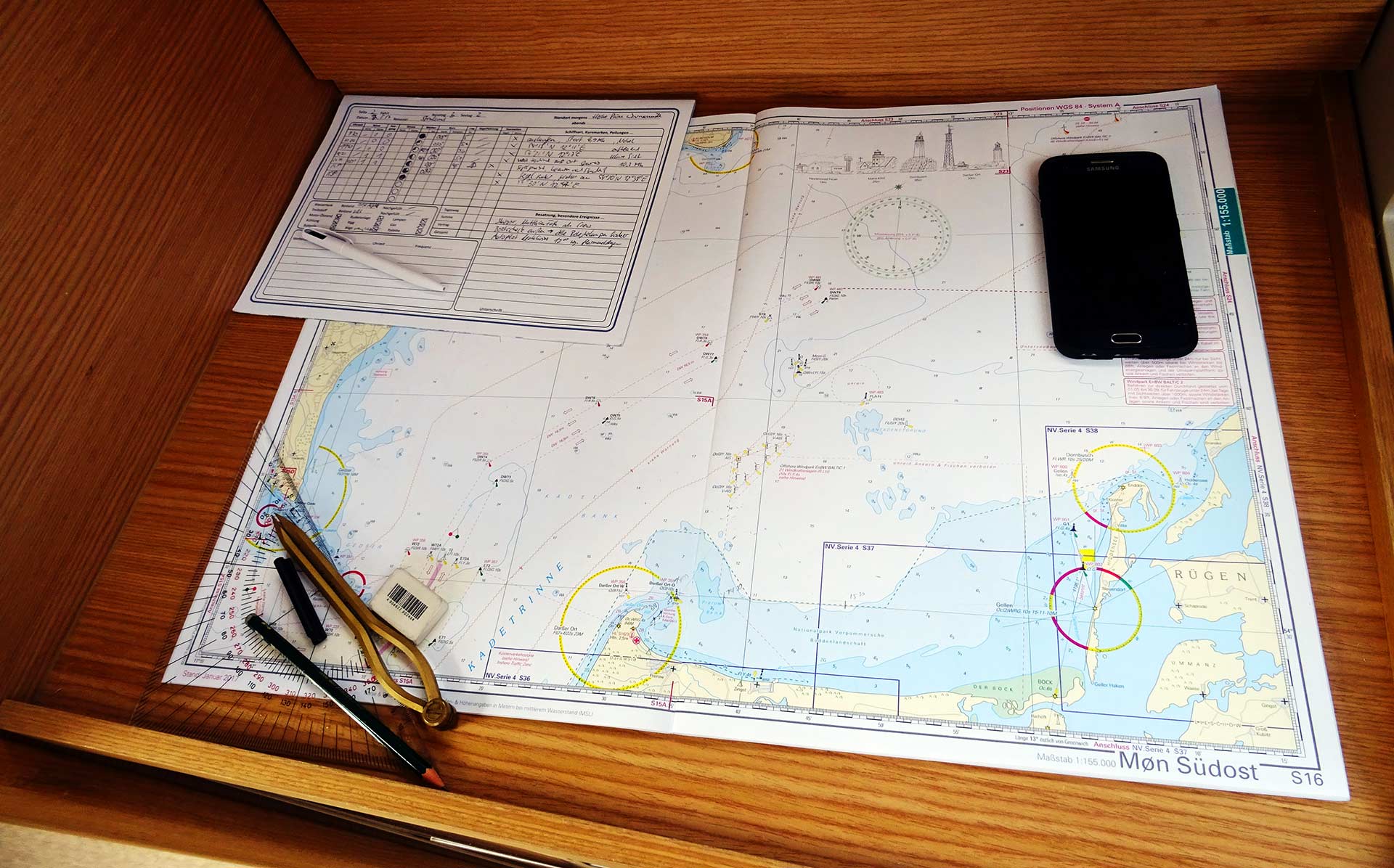
The company where I chartered the yacht required me to keep a logbook anyway, but even if they wouldn´t insist in doing so, I would have kept one nevertheless. As they´ve provided me with a blank log, I tried to keep the logbook as thorough as I could although I found it really hard to discipline myself to have filled in all the blanks thoroughly. I sometimes failed to keep the weather data, for some days I didn´t kept the sea-related data, sometimes I found it hard to fill in wind-data. But I always kept the important ones: Time, course and speed and position.
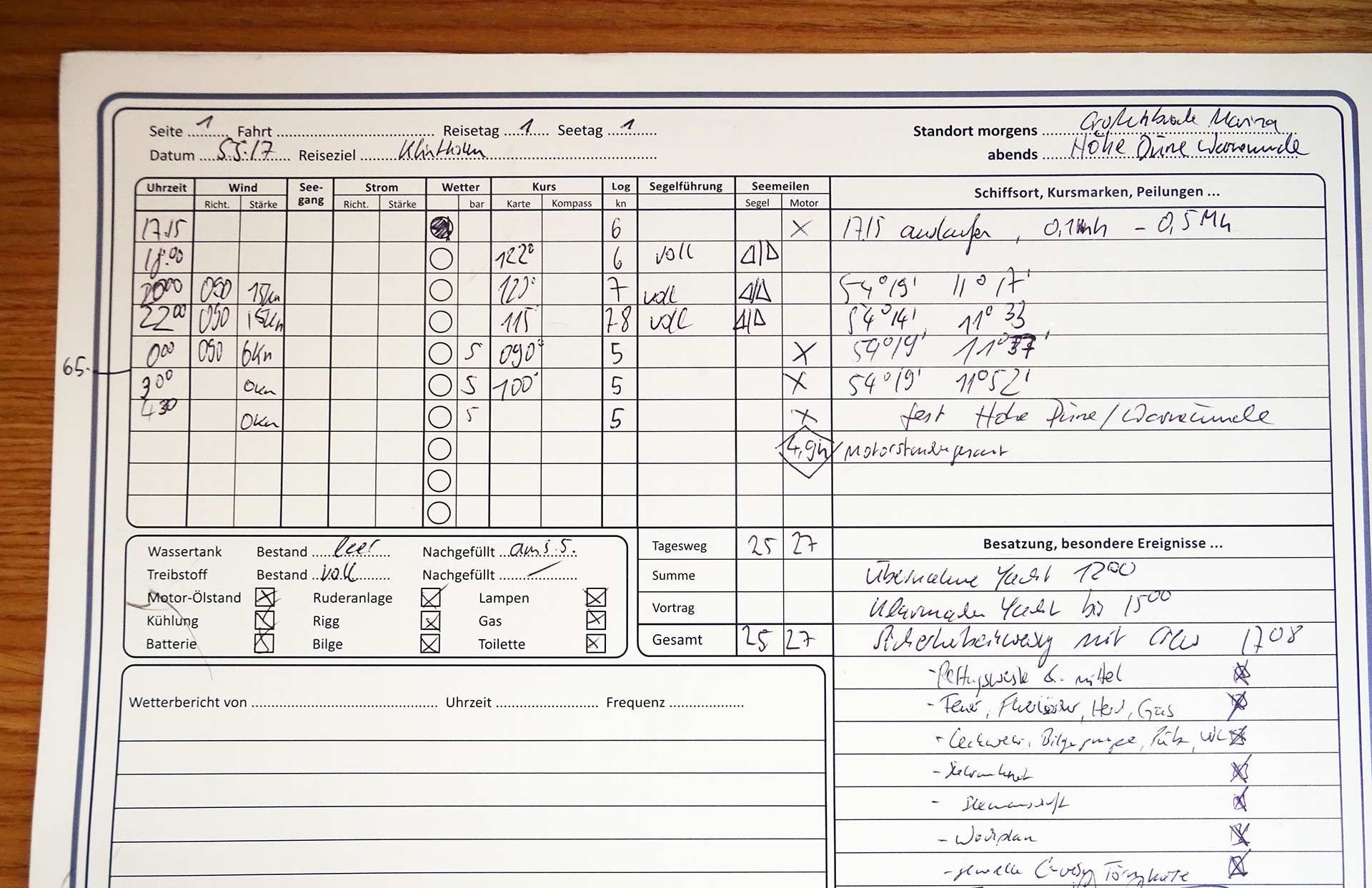
The logbook should be kept regularly, this is my firm belief. Especially when you are chartering a boat, having a well-kept log could save you from legal hustle as the logbook is official proof in court when things go badly wrong. This happens to be true for minor disputes because of insurance-trouble as well as for the wort scenario, if something happens like a MOB-case. That’s why on the first page I do write down which topics the crew briefing mentioned.
Onboard routine & scheme of watches
Speaking of “things gone wrong”, on my first ever trip as skipper these things happened too. Although no real catastrophes took place, there were two or three occasions where I must admit I acted with poor judgement, or let´s put it this way: More experienced skippers wouldn´t have come in this trouble in the first place. I am talking of casting off.
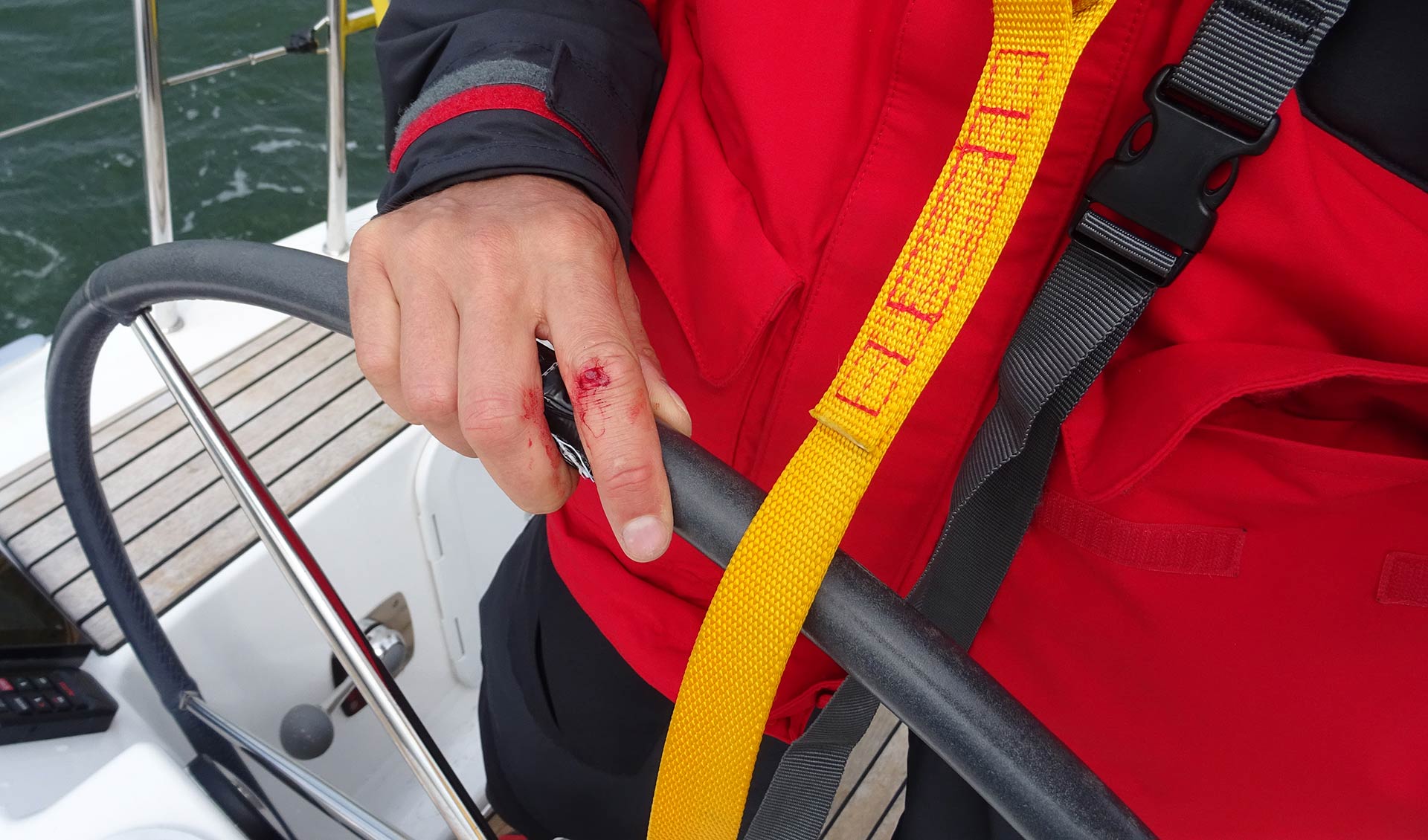
It happened right on the last day of our trip when we were taking in all lines in Gedser/DK. We´ve had a strong blowing seaward wind with 15 knots and rising. I tried casting off by means of a seaward stern rope (putting away the bow from the jetty) but it didn´t work out well because we didn´t have had enough fenders on board (read about this technique here), so I did it the classic way: Steaming into the bow spring. Which went very well, but upon setting back the boat I tried to bring her around on the spot, which I also did pretty well, but I didn´t push the engine too far to have the boat running free and we drifted toward a boat at the jetty. Chaos broke out as the crew – and myself – dashed to the port side to throw some fenders between us and the other boat, which we managed to do without damage. To the boat. I jammed my finger between us two. Bloody f***k!
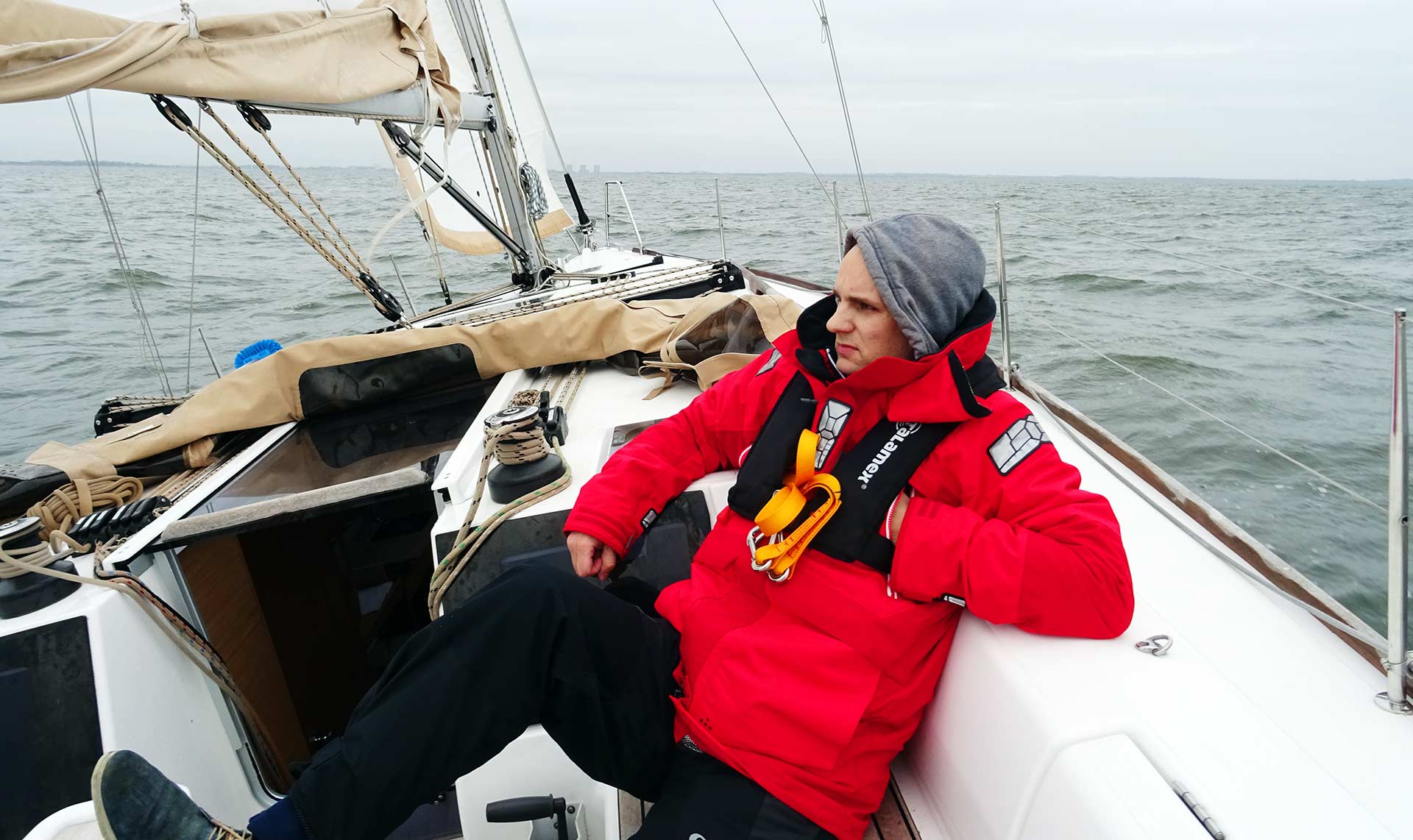
So I´ve learned – again – that, besides the old saying “less wind – less throttle: more wind, more throttle!” is really a true and wise thing, but also having a Plan B in advance is what every skipper especially in critical conditions like landing and casting off should have prepared and possibly laid out to the crew as well. This will prevent chaos, damage and injuries. My ego was a bit scratched, I must admit, but on the other hand: This particular day no other yacht was leaving port due to the steady 6 Beaufort. But I did. Another thing was seasickness (read about own experience here and what to do here). Just one hour after we´ve started the trip, I noticed my crew mate Mathias turning pale, getting more and more quiet and after I asked if everything is okay he jumped to the transom to feed the fishes. No further action was needed, but later, as we´ve had our guest Julia on board, I sent her down to her berth when I noticed the same symptoms with her. After four or five hours of sleep, she was fine again. Keeping an eye on the crew and the people in good health is also a task for the skipper.
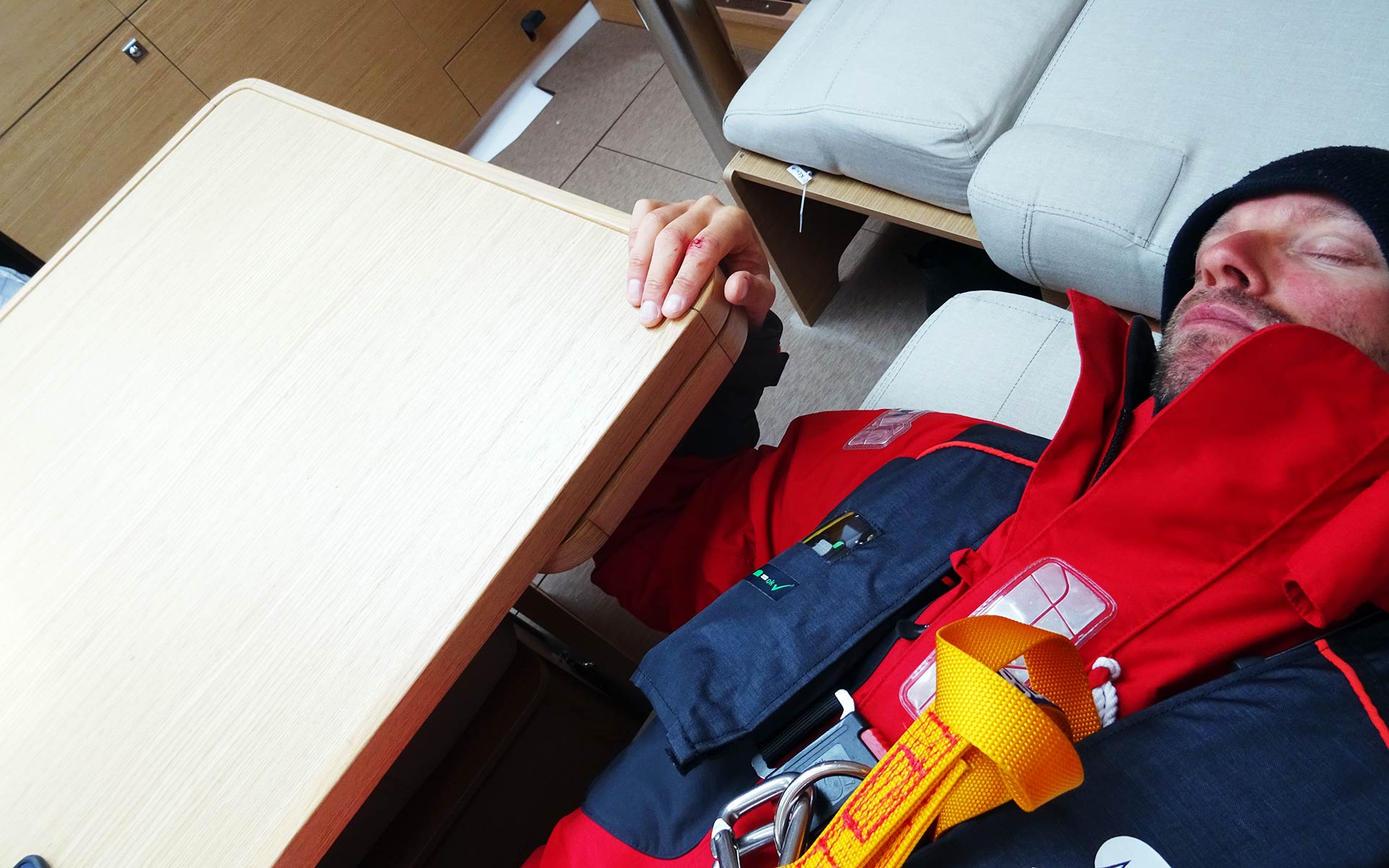
Which also applies to my own person of course. As I mentioned before, I found it hard, especially at the beginning of our trip, to relieve myself from command and hand it over to Mathias to go down below, do the chart work and log and pack myself to the berth to seek some two hours of sleep, or rest at least. The more watches we went through, the more confidence I also gained in Mathias´ abilities and the assurance that my instructions concerning the course to be held had been implemented to my best satisfaction. We maintained a 2-hour-shifts watch system for 24 hours which we believed would be best for both being as alert as could be while on duty and provide for enough time to find some rest.
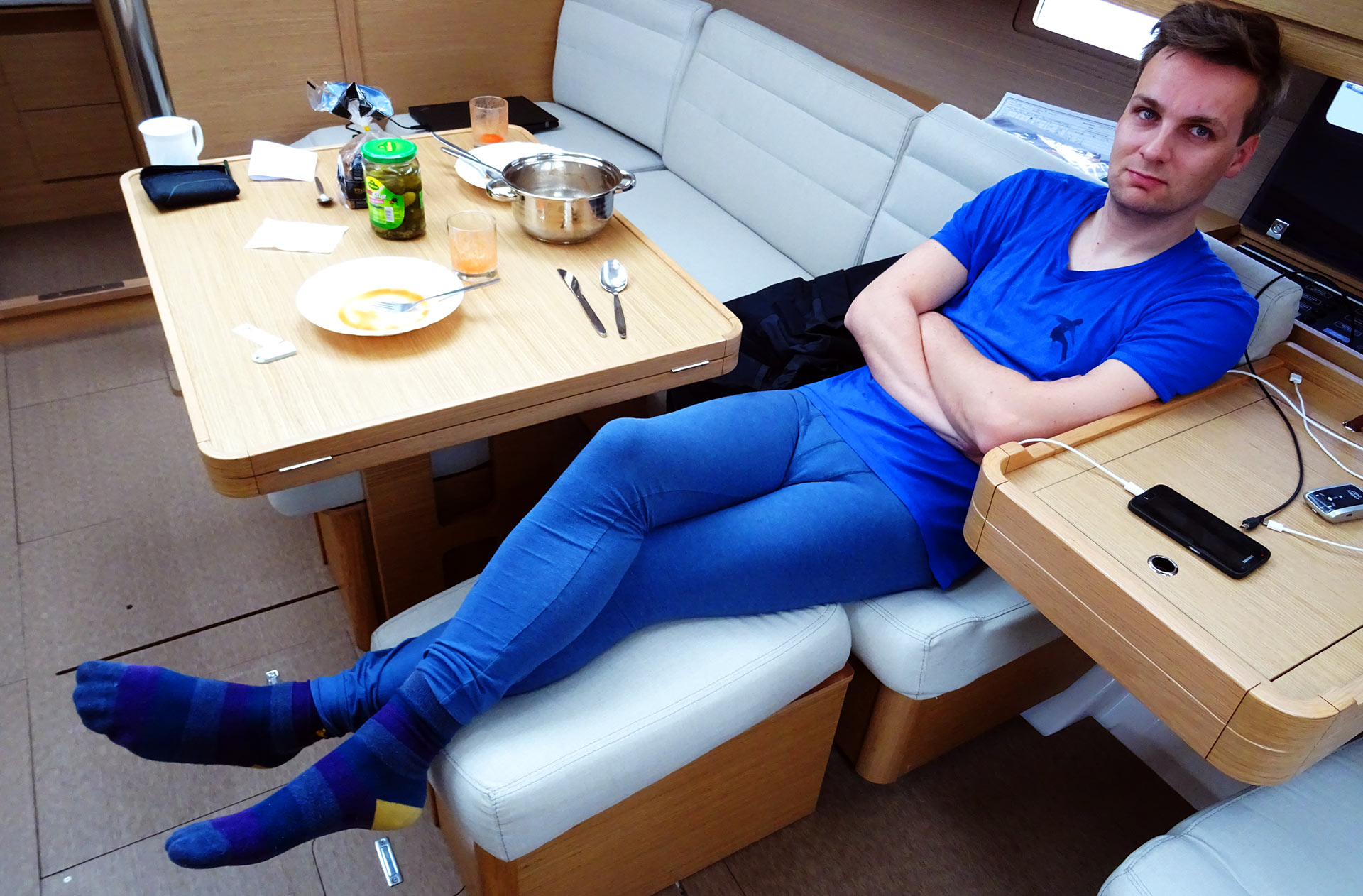
What was also of my utmost concern was that the crew felt comfortable with the trip. That’s why I was lucky to put on the heating system whenever we were tied up to the pier sides and it turned cold outside. I also planned the provisions in a way that we would have delicious food for all three major suppers per day, enough sweet and salty stuff as well as apples and other vitamin-treats to snack on. Well, that´s normally the job of the ship´s cook, but lacking such a crew member, I took this as my own responsibility. I must say, it worked, as we´ve had a leisure, relaxed atmosphere with a lot of jokes but also respect between ourselves.
First Maneuvers
I just love sailing in the dark. Since I´ve been behind the steering of a small harbour cutter steaming through Hamburg port (read it here) I am fascinated with running a ship at night. As we left our starting harbour at 6 p.m. we sailed into the darkness (which was breath taking) and remained under sails until the wind was falling asleep as well and my initial plan to sail all the way up to Ystad in Sweden crumbled. As weather forecast was likewise depressing and we´ve had a schedule to live up to, I decided to go for Rostock/Warnemunde harbour. I was puzzled by the Rostock fairway which reminded me of a landing strip for aeroplanes. No problem with navigating by night whatsoever.
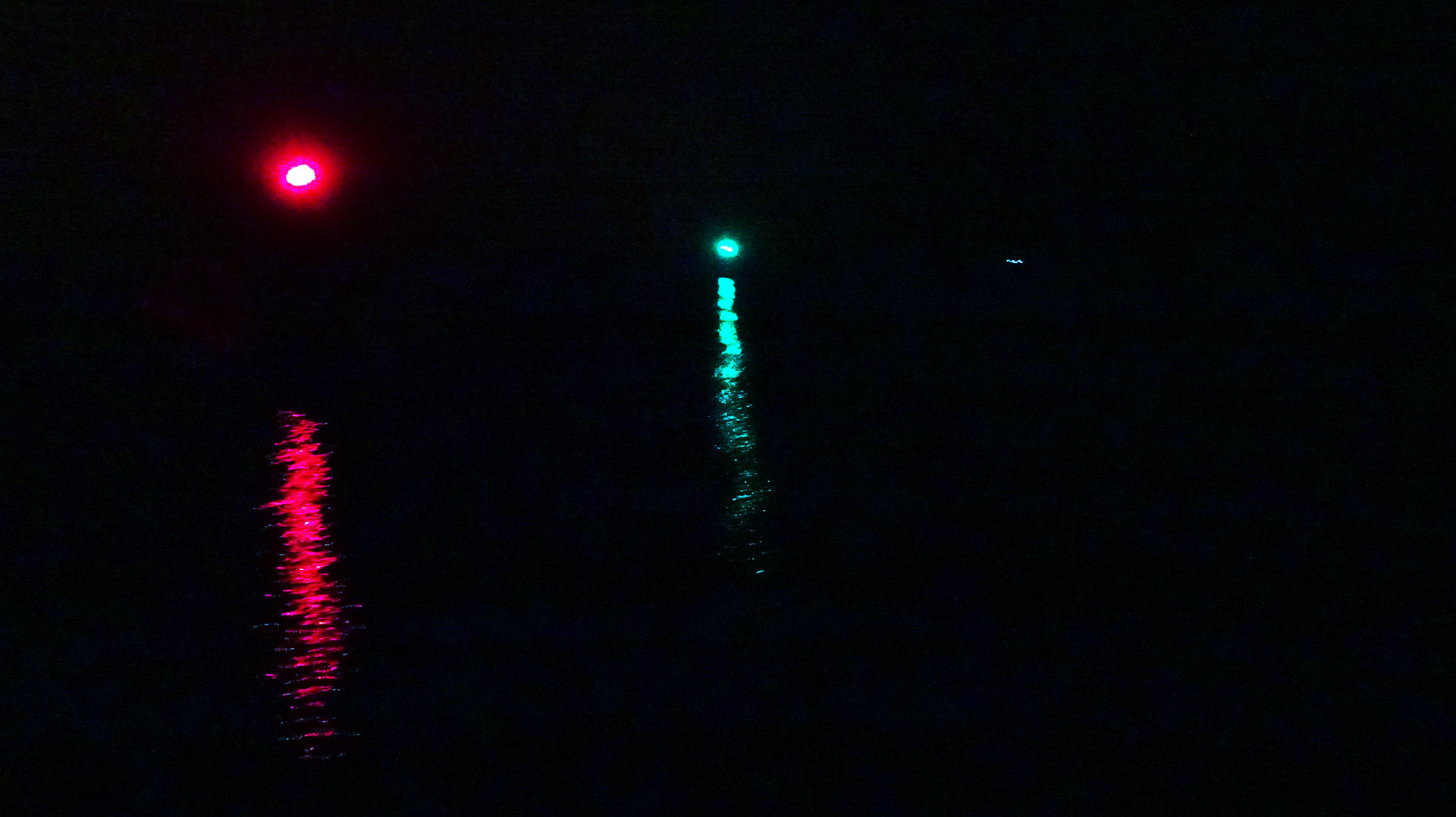
As we reached the marina there was no wind at all and the water was smooth like a sea of black oil. As it was early in the season there were a lot of berths unoccupied and so I applied standard landing maneuver as learned during the SKS/RYA Coastal Skipper class – steam stern ahead right upon entering port, be nice and slow. This gave Mathias enough time to get all the fenders and lines prepared and we managed to land the boat in a very neat, elegant and unagitated manner, which made me very proud.
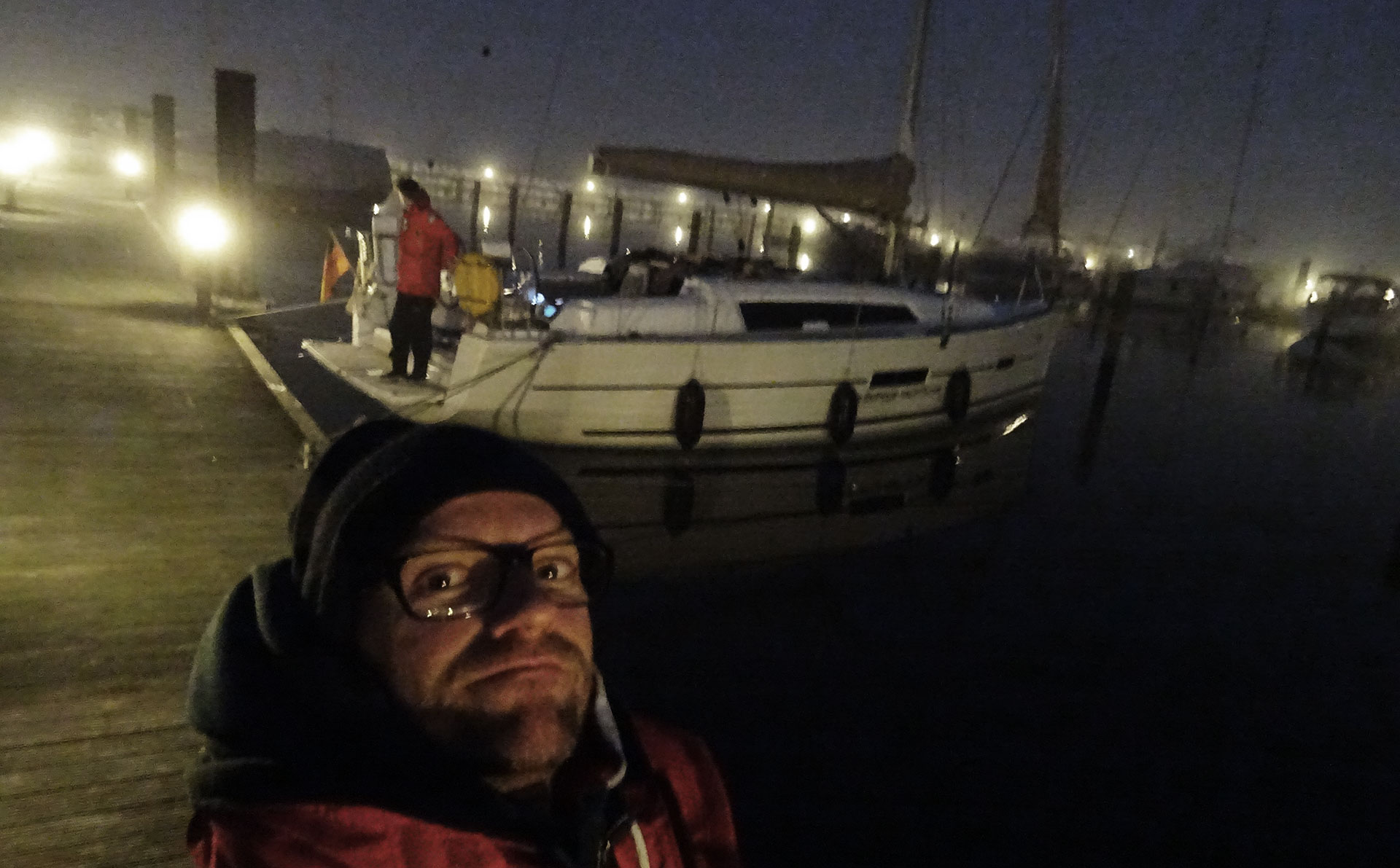
Getting off again as well as all harbour maneuvers in Stralsund for the whole coming week have been a great opportunity for me as well to practice my skills in this matter. Everything was going fine and I must say that it is really true that you will gain confidence in your own capabilities the more you actually do the things like landing and casting off by yourself. In the end, I was pretty confident in my abilities and those of my crew so that I decided to have a go in Gedser when all the other skippers remained in safe harbour.

I described the bad maneuver in length in this article, but what I´ve really learned by making this mistake was – as I have seen it with other skippers too – actually nobody is immune to making mistakes. What really counts is whether you have a Plan-B or not and that you must remain calm and sure of what you do, even when chaos breaks out all of a sudden.
Onboard treats
Next to all this thinking about being skipper first time, I also found moments of sheer pleasure, of soothing and contemplation. Sailing is the best thing I can imagine spending my time and I find the Seas attractive no matter how the weather is, no matter how cold it is and no matter how shitty other would find it – I just love being out there and have the canvas set proudly. This is what we´ve did.
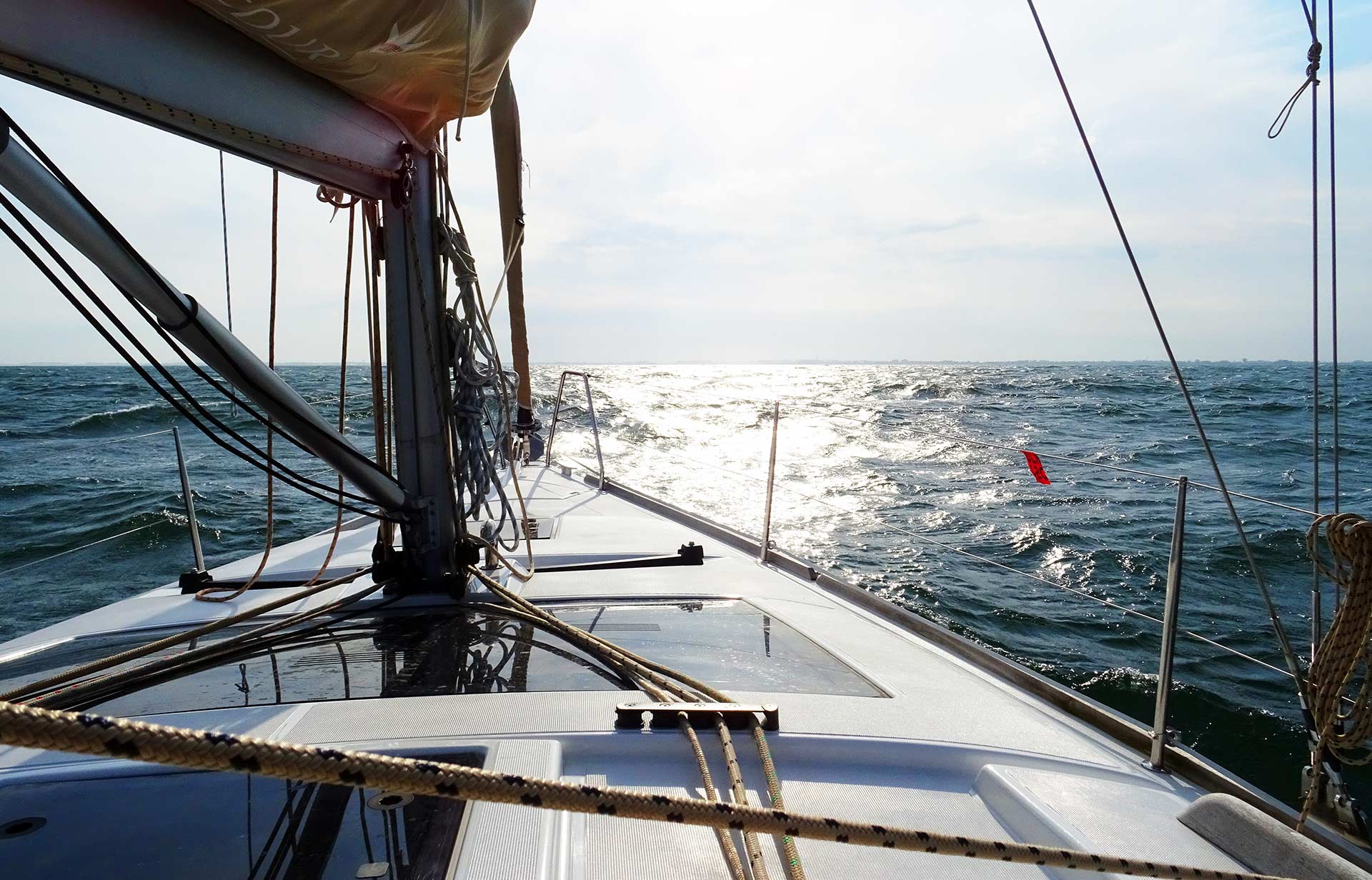
The Baltic Sea was showing a lot of her different faces: Strong, gusty blows on the first day with a dead flat calm for three consecutive days. Then again gusty winds, forcing us to the second reef and still heeling the yachts quite heavy. We´ve had burning sunshine making us sweet as well as horizontally falling rain soaking our heavy weather gear. I forced myself to let go for some minutes, to free my mind from the burden of command and just enjoy the sailing pleasure. As well as down below deck.

We´ve managed to find a very well balanced crew spirit which I now think was one of the greatest learning of this trip: Being a thorough, straightforward seafarer when behind the steering wheel on the one hand and on the other hand let go of everything, have some nasty jokes and “manly” humor during off-duty and in port. This kept moods high and the crew willing to follow.
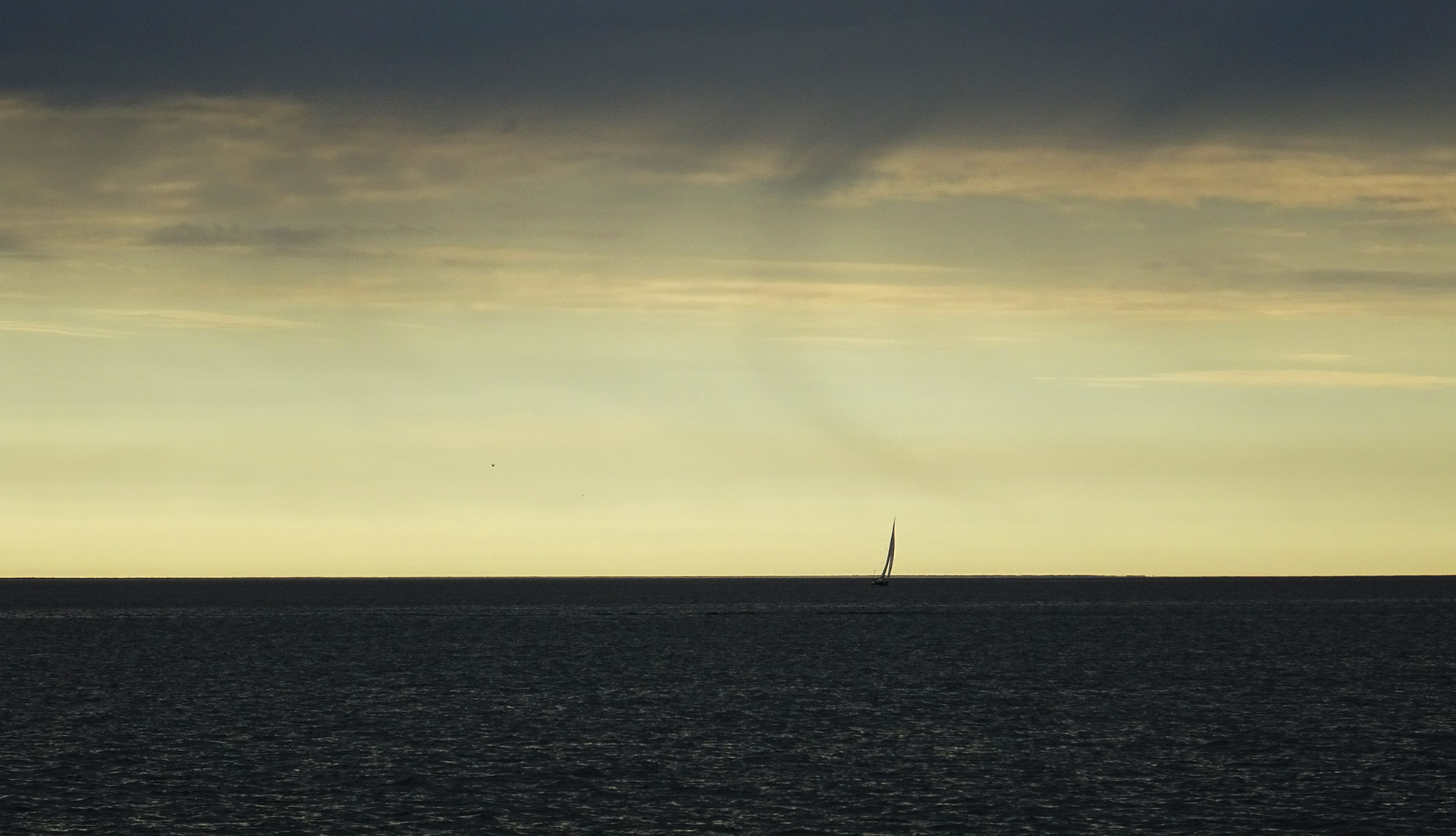
In the end, Mathias and I were functioning so good that we took on a guest to the yacht, Julia, who was sailing with us all the way back and remained aboard for three days. It was her first ever experience on a sailing yacht and I think we were able to offer her a truly nice pleasurable sailing trip with insights into this delightful way of spending time out on the seas. Being able to enthuse somebody for something is always a great reward.
Welcoming guests
Let´s get into this a bit deeper. As I mentioned at the beginning, safety was of my utmost concern. Where I didn´t have had to explain things to Mathias as he is a sailor too, it was different with Julia who had no knowledge at all of the customs and regulations aboard a seagoing yacht. So I also briefed her thoroughly – but trying not to overwhelm my guest with safety-stuff.
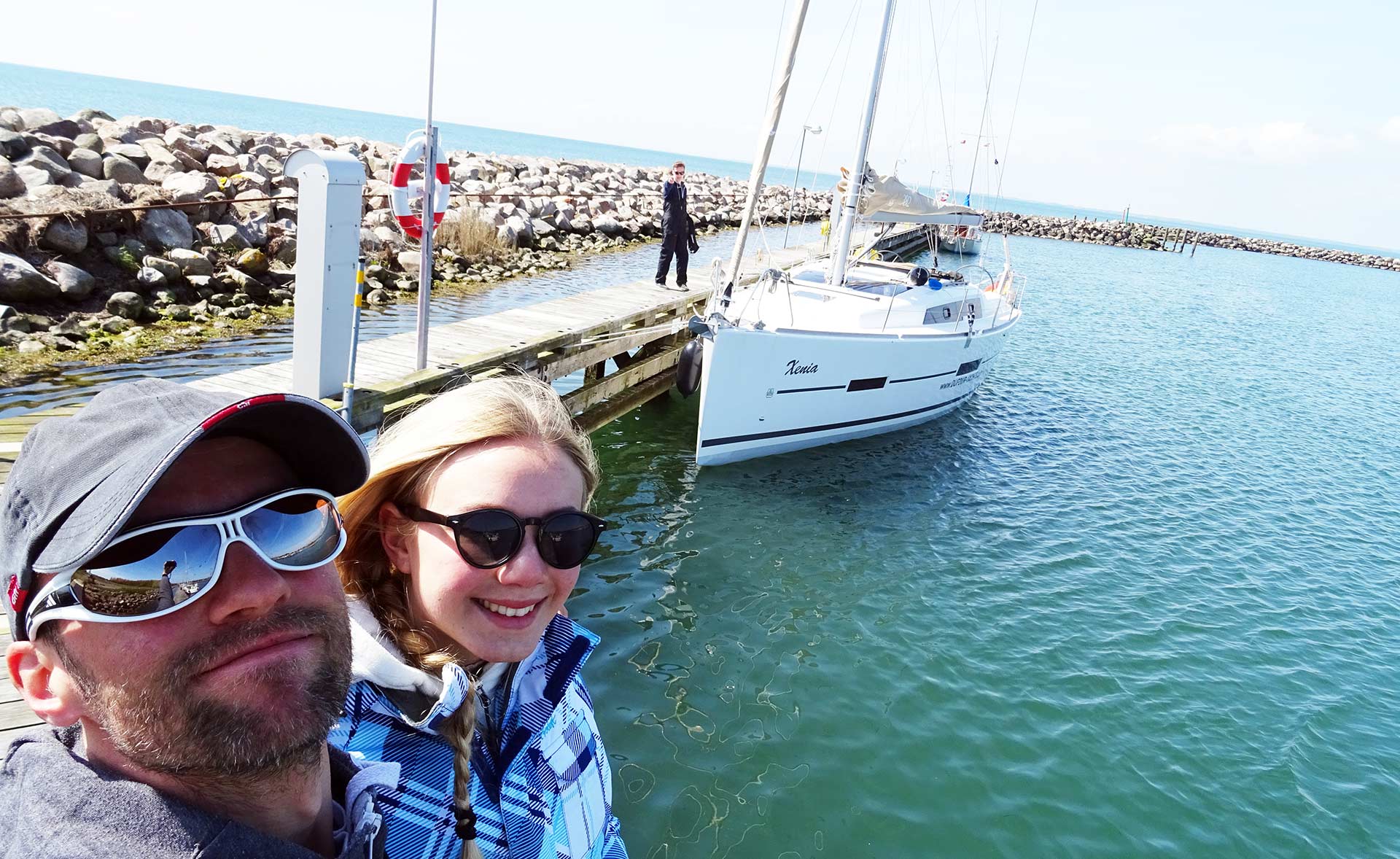
I also tried to let her take over steering when conditions permitted to do so and I incorporated her into running the ship´s routines from the first day onward. At first she would be stand-by with a “last resort”-fender, later she would be trained to handle landing ropes and even open and close the lazy bags underway. This gave her confidence, saved her from all too much symptoms of her seasickness and I am sure this also enhanced her fascination with sailing.

Leaving Gedser was tricky for a handful of reasons: First, we´ve been an relatively unexperienced crew of two sailors and one landlubber. Second, there have been strongs winds, still increasing in intensity with active gale-warnings coming in, a rising swell pushing us toward land. This wind was pressing us inevitably onto the lee shore. Fourth, leaving Gedser harbour in these conditions was tricky as you´d have to follow strictly a very narrow fairway. Besides it, the depth will rise from 3 meters to less than 50 centimetres abruptly: High waves, ever-pushing strong winds and a very strong current posed a threat to our small 30 hp-engine. When we finally reached open water, my hands were shaking and as the waves reached 1.50 to 2 meters, I ordered all onboard to have their lifelines attached to the boat.
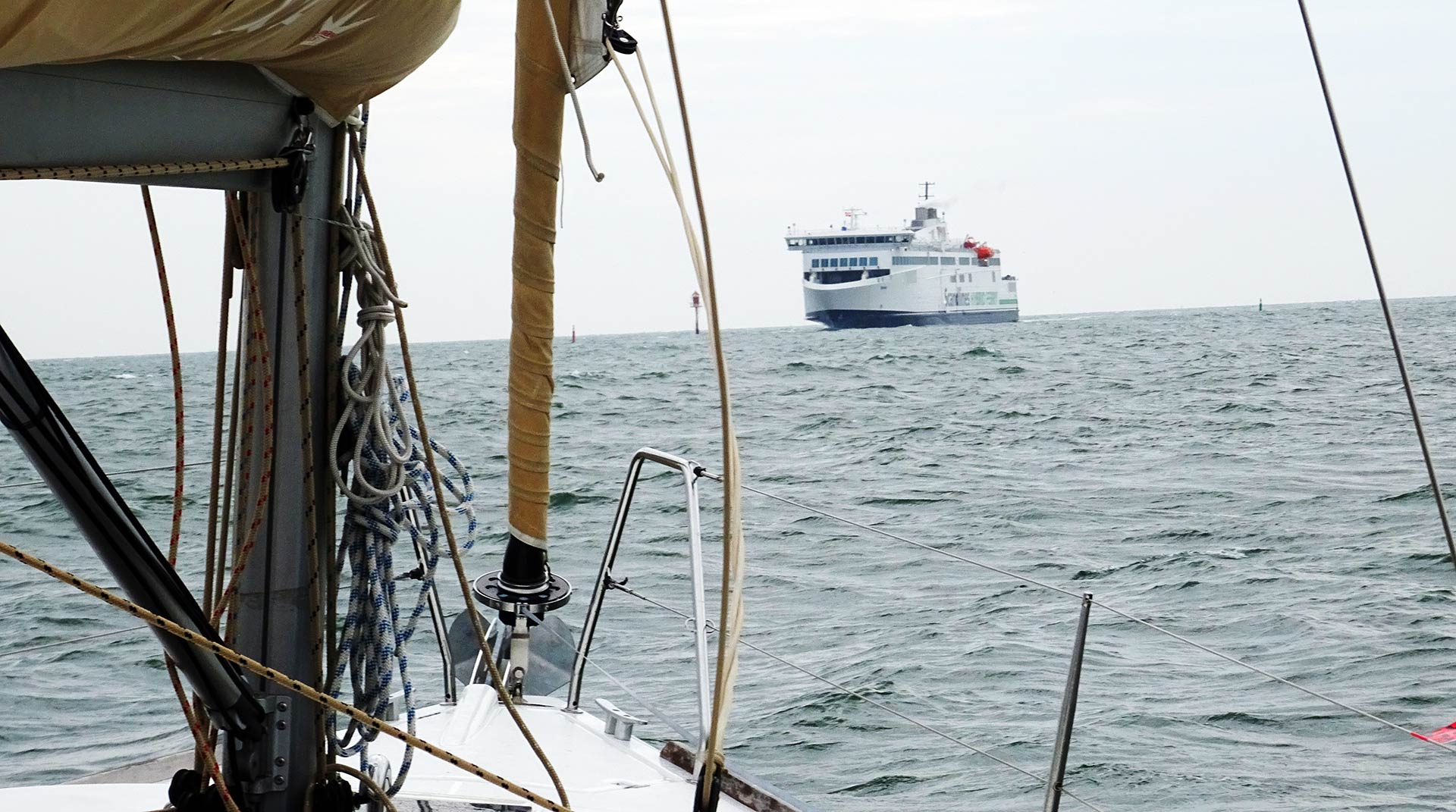
Leaving Gedser also means to follow a fairway for the ferry to Rostock. Next to the fairway there´s no imminent shallow, but with such high waves I´d rather not risk to set the keel aground. Steering the boat in the fairway and keeping my distance to the huge ferries was also bit of a rise in blood pressure, but we´ve also managed to pass through with no problems. I did learn so much there, believe me!
Making decisions
Hardest of all was really to make decisions in the first place. That´s because nobody other than the skipper is destined to do so. But I found it quite hard to decide whether to make it this way or another. Some of the decisions had been made without problem, like all the safety-related stuff. I am applying a zero-tolerance-policy with no margin for interpretations in this case. This does not leave any room for doubts for the crew. Other decisions had been harder.
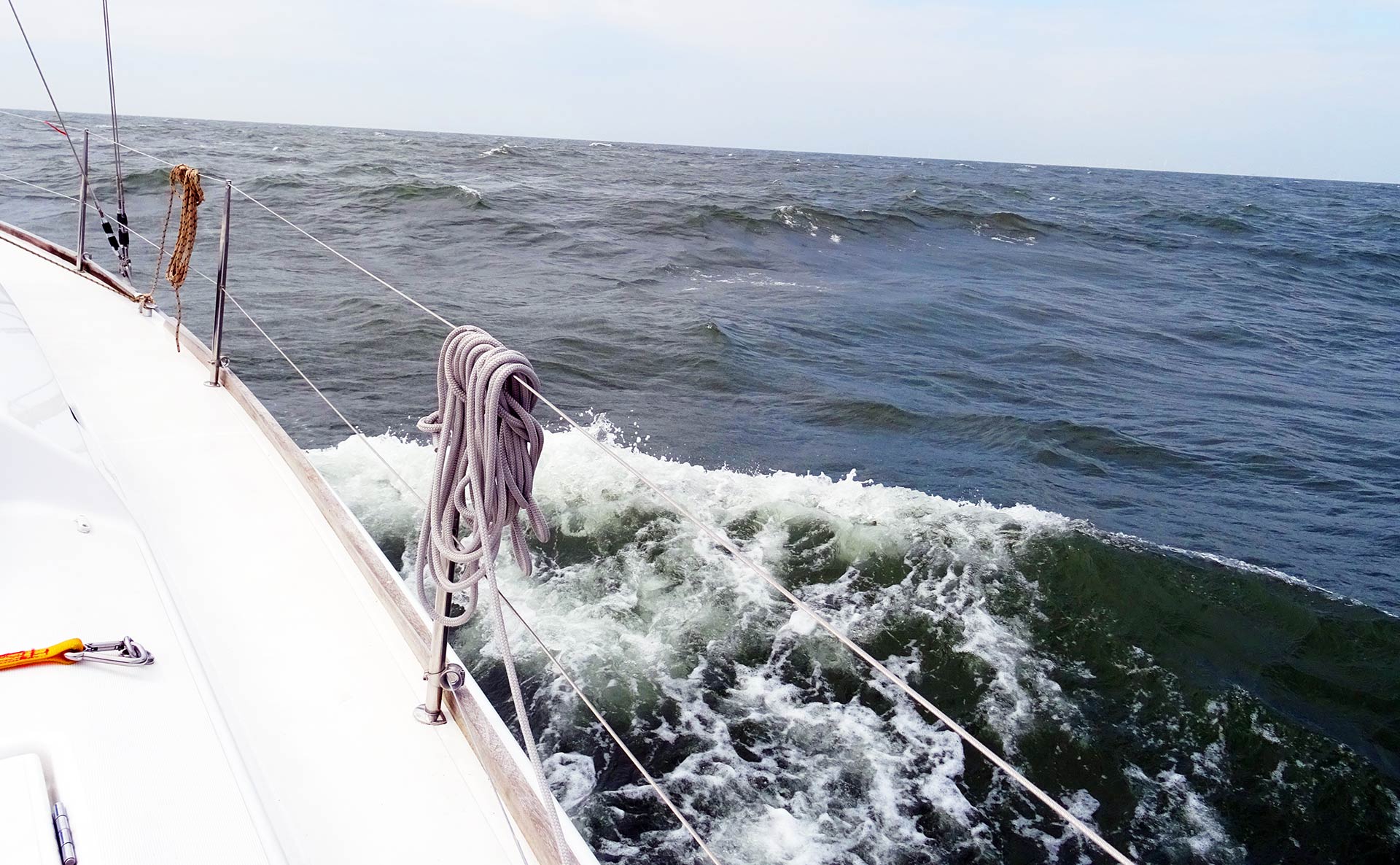
Like casting off in Gedser: There´s a 150.000 Euro boat under my command. If anything happens to the yacht, or worse, the people on her, I will be held accountable for. So I if had a doubt that a certain decision might not be the right one, I simply went back a step and calmed myself down. This is why we´ve tried to cast off in a certain way before actually casting off. This took off pressure from both myself and the crew. It provided me with the data I needed to make my final decision. This was very good, I assert myself now that some time has passed.
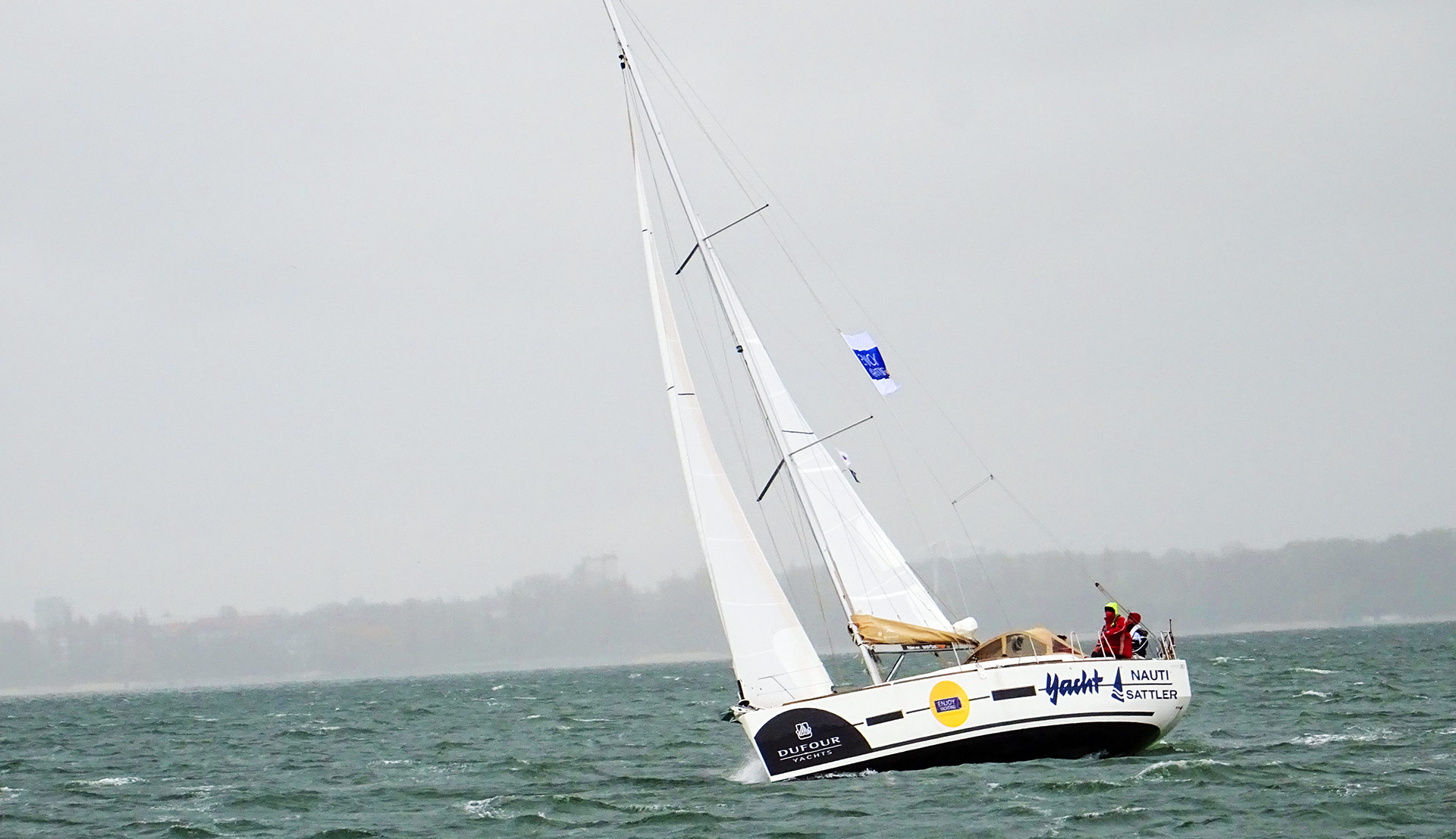
There was also an occasion when we´ve had the training session with the VIPs off Stralsund when a thunderstorm approached and heavy gusts rolled into the bay, making our boat go as fast as hell, but also heel her to the washboard. I ordered the first reef to be put in pretty soon, because a lot of skippers told me things like: “The moment you think you´d might be putting a reef in – put in a reef!” And we did good in doing so, did it spare the boat´s rigging and equipment from heavy loads.
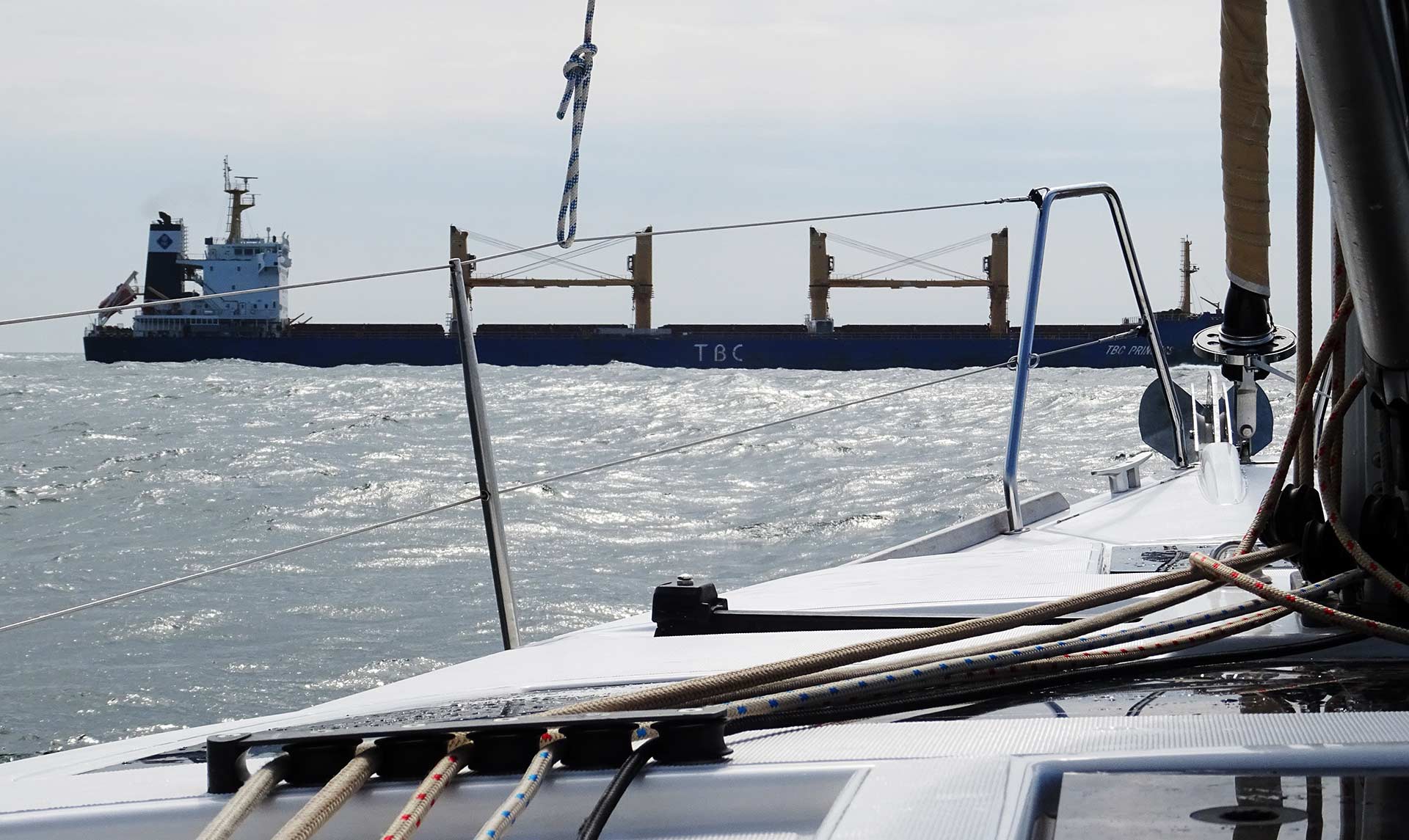
There was also one occasion in which I had to get out my whole authority to get things right. I was off duty and got up after one hour to get a short glimpse of the situation outside. I was poking my head out of the entryway when I realized that we´ve had standing bearing to a huge freighter some 1.000 meters away. We were crossing a commercial shipping lane. Mathias was calm, smiled and said a thing like: “I will pass him short behind his stern”, when I shook my head and ordered a rigid change of heading to signal the ship that we give him right of way. To Mathias: “You don´t pass shortly here, we won´t make the helmsman on the freighters nervous!” He understood.
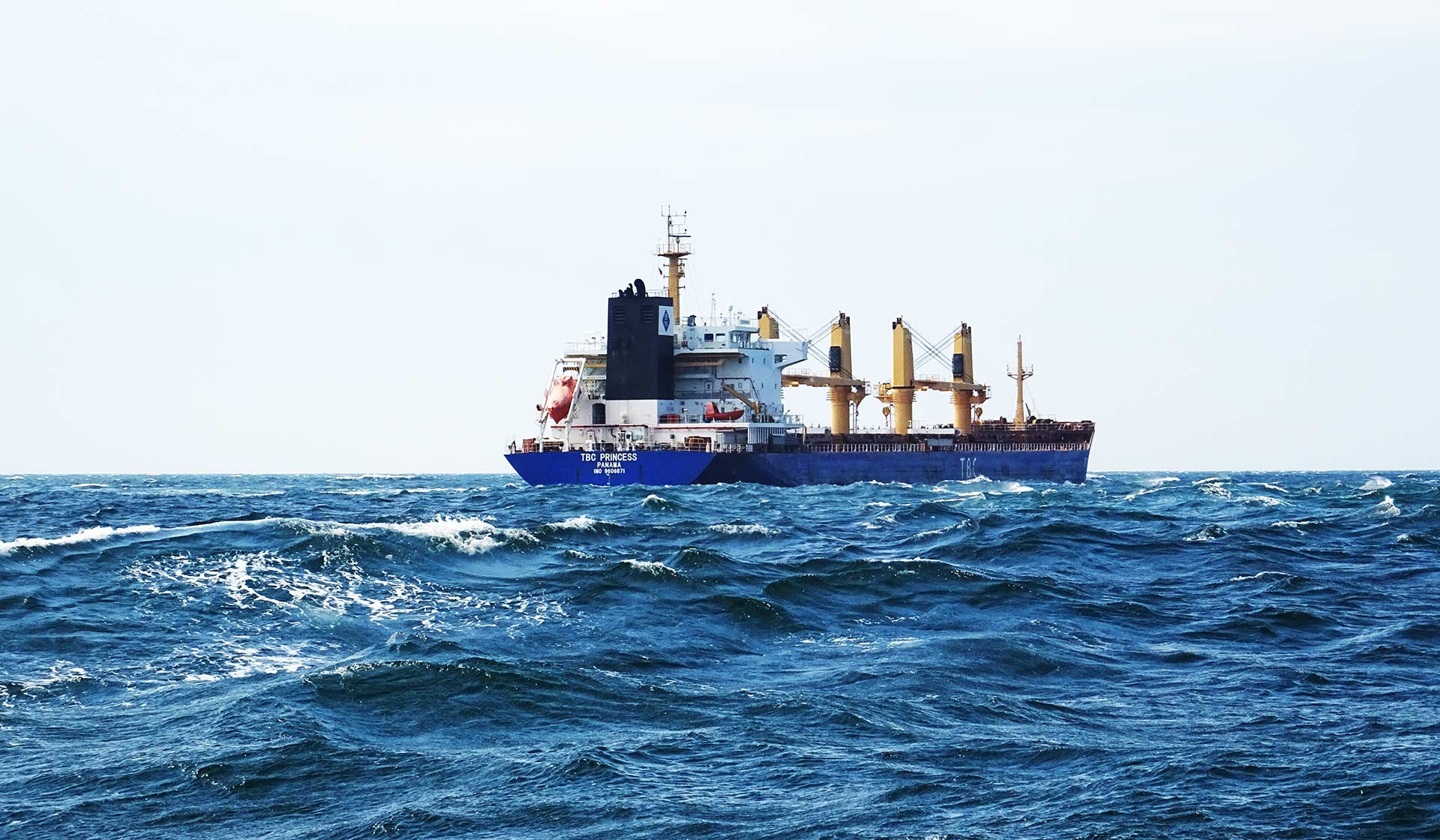
I also adjusted my watch patterns when I noticed an increase in shipping traffic, just to be sure that everything went right in the first place. After 5 days it didn´t bother me anymore not to get a real good and deep sleep, I did not get to take a thorough showers for four days because when the others went, I was planning the next leg of our trip, checking the engine or the provisioning. I was there for the yacht and decided to offer myself a treat only when my work was done properly. That´s the difference to being just a deck hand or a helmsman: You are not responsible. A skipper is.
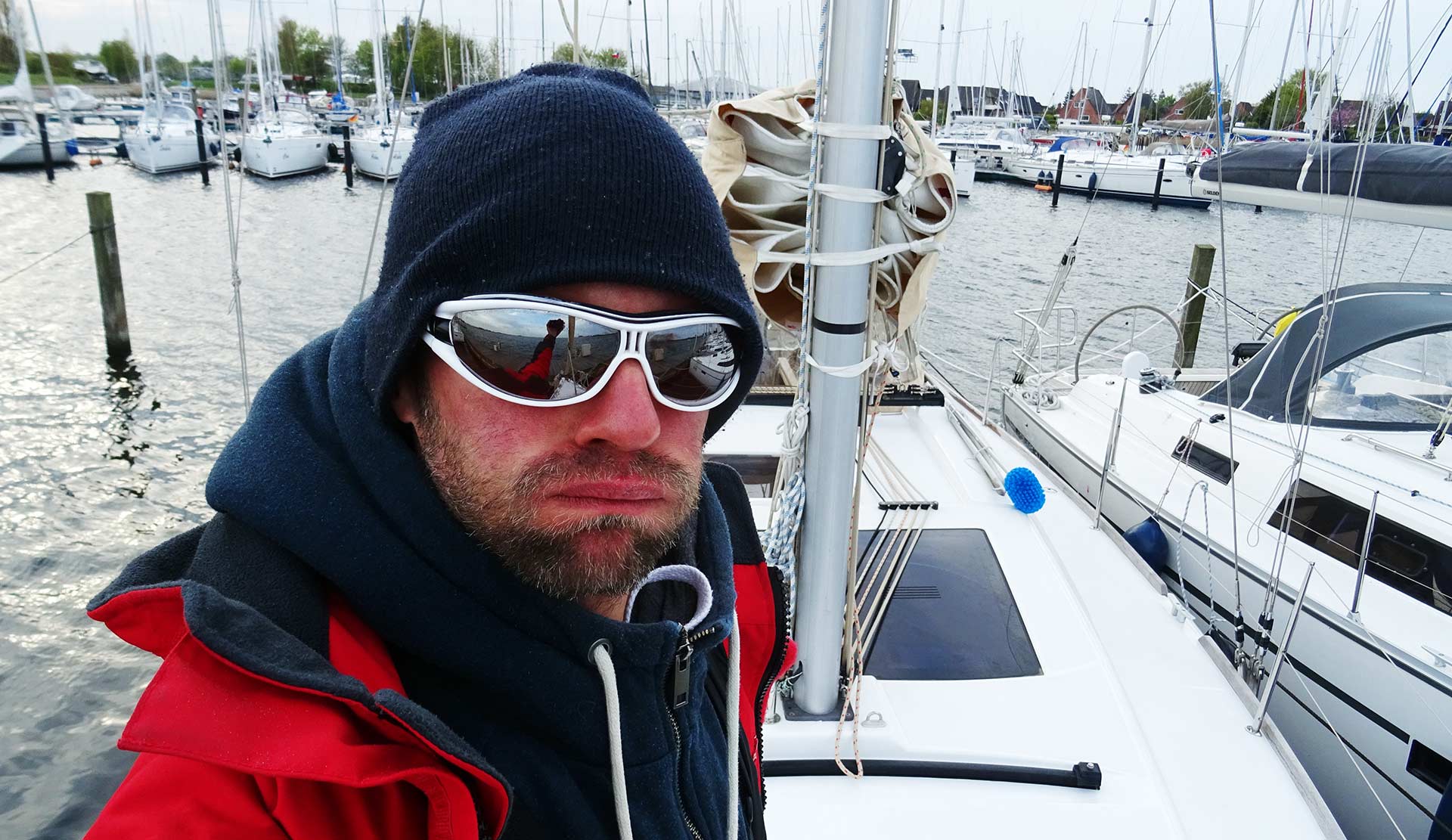
The last big challenge was landing in Grossenbrode again. As I mentioned, we´ve had very strong winds (28 knots true wind) that was pushing us onto lee shore. I transferred our position to the paper chart every hour in the end and corrected heading ever so slightly. I knew that we would only get one chance to bring home the boat safely: Grossenbrode is a very small marina with a very narrow entrance. The entrance is also a sharp 90 degree turn in a very, very narrow fairway right next to the shore line. With waves displacing the boat one or two meters this was a tricky approach. I gave full throttle and dashed into the harbour, which was good. Landing (still gusty!) took me no less than three runs to have SY XENIA tied up safely. You can imagine my relief!
An assumption
In the end, this was a very, very intense experience for me. I am proud of my performance as a skipper because both my own assessment as well as crew´s feedback assert that basically everything I decided and did I did in a good fashion and the right way. I am not really proud of the casting off-maneuver in Gedser, but that´s normal learning curvature I guess.
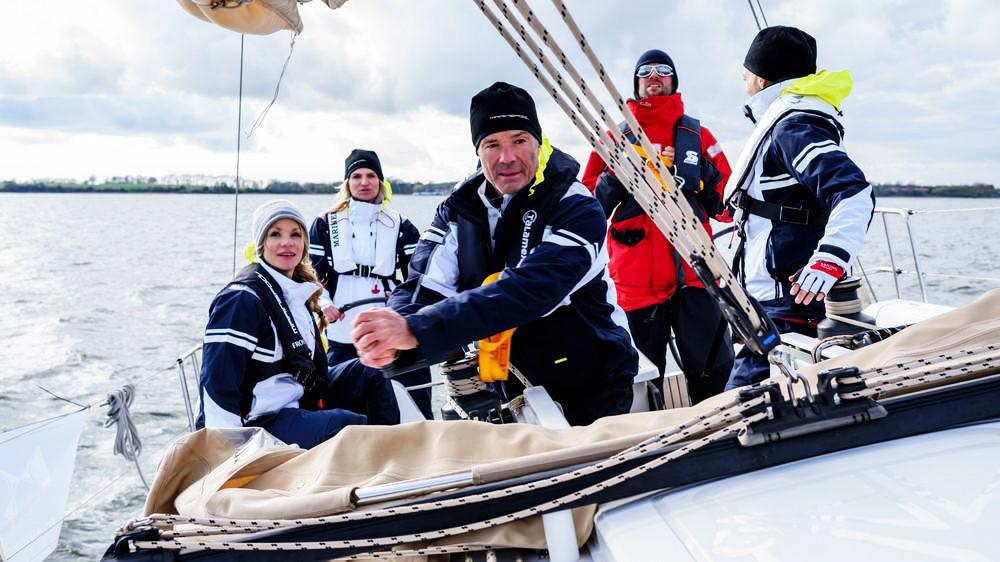
It was never intimidating, always challenging and great fun to be skipper first time. It´s addictive and seductive. I cannot wait to grab my next chance to be behind the steering and in charge of a yacht again. There are things I will stick to – probably for the rest of my sailing life – and other things I look forward to be taught making them in a better way than I did in the first place.
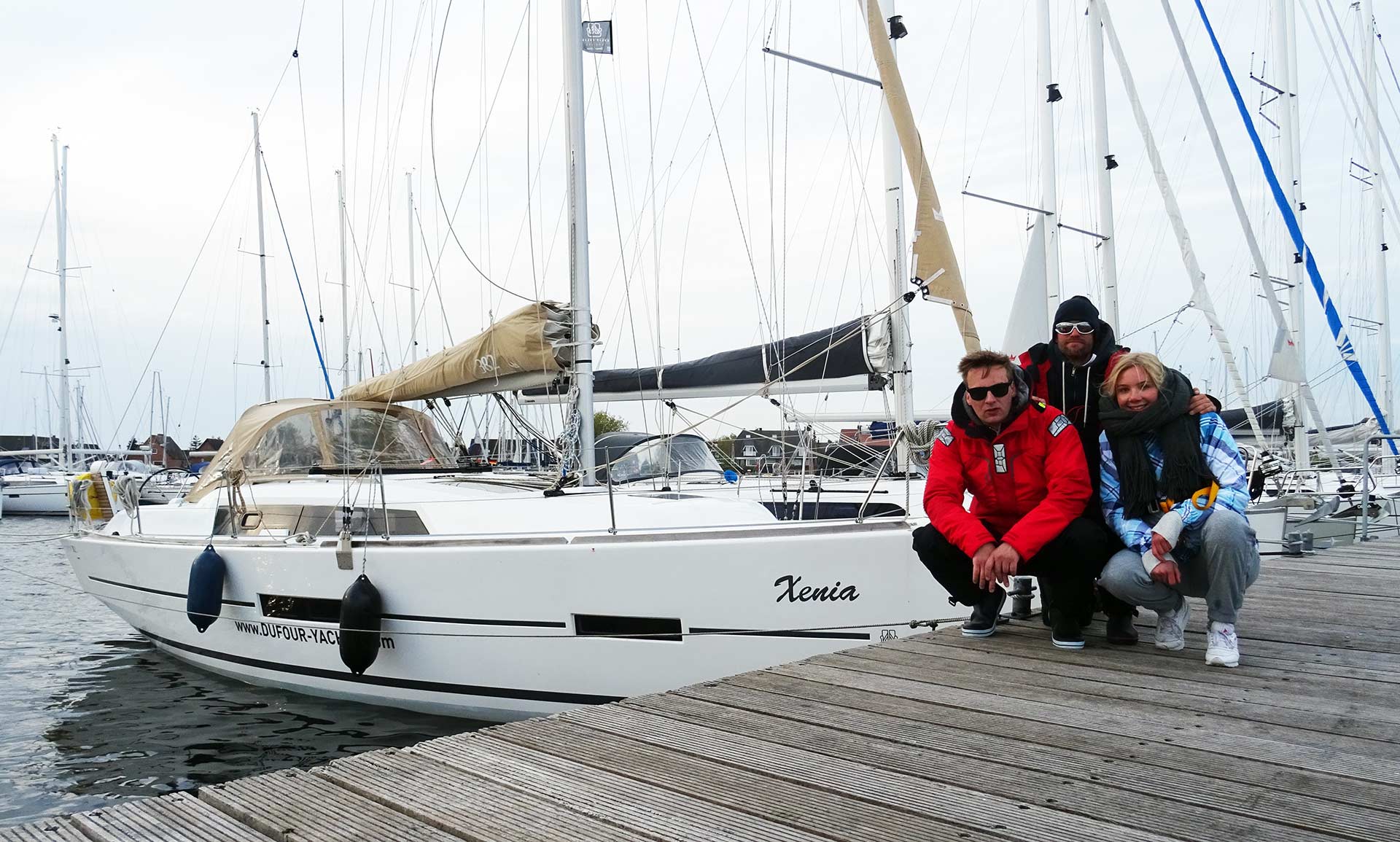
After 300 nautical miles and seven exciting days, we´ve left SY XENIA and returned to our “normal” lives. But for me, this sailing experience will always and forever remain in my memories as this one single trip, that will never ever will come back again – the trip when I was skipper for the first time of my life.
Other interesting articles on that topic:
What makes a good Skipper?
The view of a female Skipper
RYA Coastal Skipper Examination
